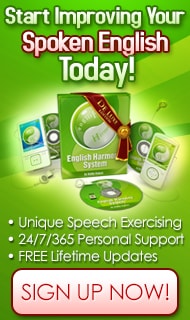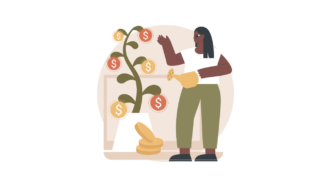

SpeakUp resources
Starting a presentation in english: methods and examples.
- By Jake Pool
If you’re going to make it in the professional world, most likely you’ll have to give a presentation in English at some point. No reason to get nervous!
Most of the work involved lies in the introduction. You may or may not need an English presentation PPT file, your topic, audience, or time limit may vary, but a strong opening is a must no matter what! Everything that follows can build from the opening outline you present to your audience.
Let’s look at some guidelines for starting a presentation in English. If you can master this part, you’ll never have to worry about the rest!
Opening in a Presentation in English
While it’s important to have your entire presentation organized and outlined, planning and organization are especially important in the introduction. This is what will guide you through a clear and concise beginning. Let’s look at how to start a presentation with well-organized thoughts .
Introduction Outline
- Introduce yourself and welcome everyone.
- State the purpose of your presentation
- Give a short overview of the presentation
As we say, it’s as easy as 1-2-3. (No need for a more detailed English presentation script!) Let’s examine the first step.
1. Introduce Yourself & Welcome Everyone
The self-introduction is your opportunity to make a good first impression. Be sure to open with a warm welcome and use language that is familiar and natural. Based on your audience, there are a few different expressions you can use to start your presentation.
If you’re presenting to coworkers who may already know you:
- Hello, [name] here. I would like to thank you all for your time. As you may know, I [describe what you do/your job title] I look forward to discussing [topic] today.
- Good morning/afternoon/evening everyone. Thank you for being here. For those who don’t know me, my name is [name], and for those who know me, hello again.
If you’re presenting to people you’ve never met:
- Hello everyone, it’s nice to meet you all. My name is [name] and I am the [job/title].
- Hello. Welcome to [event]. My name is [name] and I am the [job/title]. I’m glad you’re all here.
There are certainly more ways to make an introduction. However, it’s generally best to follow this format:
- Start with a polite welcome and state your name.
- Follow with your job title and/or the reason you’re qualified to speak on the topic being discussed.
2. State the Purpose of Your Presentation
Now that your audience knows who you are and your qualifications, you can state the purpose of your presentation. This is where you clarify to your audience what you’ll be talking about.
So, ask yourself, “ What do I want my audience to get from this presentation? ”
- Do you want your audience to be informed?
- Do you need something from your audience?
- Do you want them to purchase a product?
- Do you want them to do something for the community or your company?
With your goal in mind, you can create the next couple of lines of your presentation. Below are some examples of how to start.
- Let me share with you…
- I’d like to introduce you to [product or service]
- Today I want to discuss…
- I want to breakdown for you [topic]
- Let’s discuss…
- Today I will present the results of my research on [topic]
- By the end of this presentation, you’ll understand [topic]
- My goal is to explain…
- As you know, we’ll be talking about…
When talking about the purpose of your presentation, stick to your goals. You purpose statement should be only one to three sentences. That way, you can give your audience a clear sense of purpose that sets them up for the rest of the presentation.
3. A Short Overview of the Presentation
The final step in starting your presentation is to give a short outline of what you’ll be presenting. People like a map of what to expect from a presentation.
It helps them organize their thoughts and gives a sense of order. Also, it lets the audience know why they’re listening to you. This is what you’ll use to grab their attention, and help them stay focused throughout the presentation.
Here are some examples of how you can outline your presentation:
- Today, I’m going to cover… Then we’ll talk about… Lastly, I’ll close on…
- We’re going to be covering some key information you need to know, including…
- My aim with this presentation is to get you to… To do that we’ll be talking about…
- I’ve divided my presentation into [number] sections… [List the sections]
- Over the next [length of your presentation] I’m going to discuss…
That’s it! It’s as simple as 1-2-3. If you have a fear of public speaking or are not confident about presenting to a group of people, follow these three steps. It’s a simple structure that can get you off to a good start. With that in mind, there are other ways to bring your introduction to the next level too! Read on for bonus tips on how to really engage your audience, beyond the basics.
For a Strong Presentation in English, Engage your Audience
Presentations aren’t everyone’s strongest ability, and that’s OK. If you’re newer to presenting in English, the steps above are the basics to getting started. Once you’re more comfortable with presenting, though, you can go a step further with some extra tricks that can really wow your audience.
Mastering the skill of engaging an audience will take experience. Fortunately, there are many famous speakers out there you can model for capturing attention. Also, there are some common techniques that English-speakers use to gain an audience’s attention.
*How and when you use these techniques in your introduction is at your discretion, as long as you cover the 3 steps of the introduction outline that we discussed earlier.*
Do or say something shocking.
The purpose of shocking your audience is to immediately engage them. You can make a loud noise and somehow relate the noise to your presentation. Or, you can say, “ Did you know that… ” and follow with a shocking story or statistic. Either way, the objective is to create surprise to draw their attention.
Tell a story
Telling a story related to your presentation is a great way to get the audience listening to you.
You can start by saying, “ On my way to [location] the other day… ” or “ On my way here, I was reminded of… ” and then follow with a story. A good story can make your presentation memorable.
Ask your audience to take part
Sometimes a good introduction that captures attention will involve asking for help from the audience. You can ask the audience to play a quick game or solve a puzzle that’s related to your presentation. Also, you could engage the audience with a group exercise. This is a great way to get people involved in your presentation.
There are many more ways to engage the audience, so get creative and see what you can think up! Here are some resources that will help you get started.
Also, if you want to get better at public speaking (and help your English speaking too!), a great organization to know about is the Toastmasters . The organization is dedicated to helping you be a better speaker, and there are many local groups in America. They offer free lessons and events to help you master your English speaking, and also offer additional help to paying members.
The Takeaway
A presentation in English? No problem, as long as your introduction sets you up for success . Admittedly, this can be easier said than done. Native speakers and non-native speakers alike sometimes struggle with getting a good start on their English presentation. But the advice above can help you get the confidence you need to lay a good foundation for your next speech !
Free practice (Facebook group)
Phone: +1 (510) 560-7571
Terms of Use
Privacy Policy
Company Home
Presentations in English

"Well Done!!!! All the basics, in an easy to use, easy to follow format! Finally, my students have some high quality, free material to use!" John Herzig, Teacher, USA
Recommended Presentation Links
- How To Speak by Patrick Winston (video) - MIT OpenCourseWare

52 Phrases for Better Flowing English Presentations
/ Steven Hobson / Business English , English Presentations , Vocabulary

Do you give English presentations at work, but feel that you could communicate your message in a more objective, fluid way?
Maybe you have an English presentation coming up and want to make sure that your speech is clear and structured so that your audience doesn’t lose concentration and stays with you all the way to the end.
A technique that can help you achieve objective, clear, and structured English presentations, is to use linking phrases that join the separate parts of your presentation together.
English presentations normally consist of an introduction, the main body, individual parts of the main body, and the ending or conclusion.
To help maintain your audience’s attention, you need to signal when you are going from one part to another.
In this article, I teach you 52 phrases that do exactly this – linking the different parts together, and therefore, making your presentation flow better. You’ll find that these phrases will act as ‘signposts’ for the audience when you finish one part and start another.

52 Phrases to Improve the Flow of Your English Presentations
The introduction.
All good presentations start with a strong introduction.
There are a number of different ways you can begin your English presentation. Here’s a simple, but effective introduction structure which works for most types of business presentations:
Introduce – Introduce yourself and greet your audience. Introduce the presentation topic – Explain the reasons for listening. Outline – Describe the main parts of the presentation. Question policy – Make it clear to your audience when they can ask questions: during or at the end?
Here are some phrases which you can use to structure the introduction in this way:
1. Good morning/afternoon (everyone) (ladies and gentlemen). 2. It’s a pleasure to welcome (the President) here. 3. I’m … (the Director of …)
Introduce the presentation topic
4. By the end of the talk/presentation/session, you’ll know how to… / …you will have learned about… / 5. I plan to say a few words about… 6. I’m going to talk about… 7. The subject of my talk is…
8. My talk will be in (three parts). 9. In the first part… 10. Then in the second part… 11. Finally, I’ll go on to talk about…
Question Policy
12. Please interrupt if you have any questions. 13. After my talk, there will be time for a discussion and any questions.

Main Body
Now that you have finished the introduction, we now need to transition to the main body, and its individual parts in a smooth way.
There are three parts of the main body of a presentation where linking phrases can be used:
Beginning the Main Body Ending Parts within the Main Body Beginning a New Part
Here are some phrases which you can use for these parts:
Beginning the Main Body
14. Now let’s move to / turn to the first part of my talk which is about… 15. So, first… 16. To begin with…
Ending Parts within the Main Body
17. That completes/concludes… 18. That’s all (I want to say for now) on… 19. Ok, I’ve explained how…
Beginning a New Part
20. Let’s move to (the next part which is)… 21. So now we come to the next point, which is… 22. Now I want to describe… 23. Let’s turn to the next issue… 24. I’d now like to change direction and talk about…
Listing and Sequencing
If you need to talk about goals, challenges, and strategies in your English presentation, listing phrases can help link these together and improve the flow of your speech. If you have to explain processes, sequencing phrases are helpful:
25. There are three things to consider. First… Second… Third… 26. There are two kinds of… The first is… The second is… 27. We can see four advantages and two disadvantages. First, advantages… 28. One is… Another is… A third advantage is… Finally…
29. There are (four) different stages to the process. 30. First / then / next / after that / then (x) / after x there’s y. 31. There are two steps involved. The first step is… The second step is… 32. There are four stages to the project. 33. At the beginning, later, then, finally… 34. I’ll describe the development of the idea. First the background, then the present situation, and then the prospect for the future.
After you have presented the main body of your English presentation, you will want to end it smoothly.
Here are typical sections transitioning from the main body to the ending of the presentation, and then inviting the audience to ask questions:
Ending the Main Body Beginning the Summary and/or Conclusion Concluding An Ending Phrase Inviting Questions and/or Introducing Discussion Thanking the Audience
Ending the Main Body
35. Okay, that ends (the third part of) my talk. 36. That’s all I want to say for now on (the 2017 results).
Beginning the Summary and/or Conclusion
37. To sum up… 38. Ok, in brief, there are several advantages and disadvantages. 39. To conclude… 40. I’d like to end by emphasizing the main points. 41. I’d like to end with a summary of the main points.
42. I think we have seen that we should… 43. In my opinion, we should… 44. I recommend/suggest that we… 45. There are three reasons why I recommend this. First, … / Second, … / Finally,…
An Ending Phrase
46. Well, I’ve covered the points that I needed to present today. 47. That sums up (my description of the new model). 48. That concludes my talk for today.
Inviting Questions and/or Introducing Discussion
49. Now we have (half an hour) for questions and discussion. 50. So, now I’d be very interested to hear your comments.
Thanking the Audience
51. I’d like to thank you for listening to my presentation. 52. Thank you for listening / your attention. / Many thanks for coming.
Linking phrases are like the skeleton which holds your presentation together.
Not only do they improve the flow and help guide the audience, but by memorizing them they can also help you remember the general structure of your presentation, giving you increased confidence.
To help you memorize, I recommend saying the linking phrases on their own from the beginning to the end of your presentation while you practice.
I also suggest memorizing the introduction word for word. By doing this, you will get off to a great start, which will settle your nerves and transmit a positive first impression.

Author: Steven Hobson
Steven is a business English coach, a certified life coach, writer, and entrepreneur. He helps international professionals build confidence and improve fluency speaking English in a business environment.
Related posts

2 Success Principles for Achieving Your English Goals

How to Improve Your Understanding of Native Speakers

How to Speak English with Confidence
Blog > English Presentation Structure (Introduction, Closing) & useful Phrases
English Presentation Structure (Introduction, Closing) & useful Phrases
02.21.20 • #powerpoint #presentation #english.
When giving a presentation in english, there are certain guidelines you should follow. Maybe you haven't got a lot of experience presenting - or you would simply like to refresh your already existing knowledge - we're here to teach you the basics about presenting and provide you with a free list of useful phrases and the basic structure you can in your presentation!

1. Structure
The general structure of a presentation is the following:
- Introduction
It is up to you to design these three parts. Using videos or everyday-examples can be a great way to introduce the audience to the topic. The important thing is that you capture the audience's attention from the beginning by making an interesting introduction. The main part is where you present your topic, ideally divided into sections. You can be creative with it - incorporate images, videos, stories or interactive polls . We generally recommend using different kinds of elements, as that makes the presentation more lively. Make sure your main part is well structured, so your audience can follow. In the conclusion, you should give a short summary of the points you made without adding any new information. You can also make an appeal to your audience in the end.
2. Useful Phrases
Here you'll find several phrases that you'll need in every presentation. Of course, you should adapt them and use them in a context that is suitable for your setting. The phrases are divided into subcategories so you can find what you're looking for more easily.

Starting your Presentation
In your introduction, you should:
Welcome your audience
Good morning/afternoon/evening everyone!
Ladies and gentlemen, I welcome you to my presentation about...
Introduce yourself
I am ... (from company ...) and today I would like to introduce you to the topic of ...
My name is ... and I am going to talk about ... today.
Icebreakers (for audience engagement)
Icebreaker polls are an amazing way to engage your audience instantly. They function as a fun and playful element at the beginning, giving you the perfect start you need to give a successful presentation. Click here to read our detailed post about icebreaker polls!
Mention the presentation topic and the reason for giving the presentation
I am grateful to be here today and tell you you about...
I would like to take this opportunity to talk about ...
I am here today to talk to you about ...
The reason why I am here today to talk about ... is ...
The purpose of this presentation is to ...
My goal today is to ...
Hopefully, by the end of the presentation, you will all know more about ...
Give a short overview of the content
To make it as understandable as possible, I divided my presentation into ... parts. In the first part, I will concentrate on ..., the second part will be about ..., ...
First of all, I will give you a short introduction, then we will move on to ...
... and finally, I will give you some insights to ...

Here are a few phrases that you could use during the whole presentation, but especially in the main part.
Engage your audience
In order to raise the audience's attention and improve their engagement, it is extremely important to make contact with them. A great way to do so is by adding interactive elements such as polls. If you would like to know more about this topic, read our article on How To Boost Audience Engagement . You can also use a software like SlideLizard , which allows you to conduct live polls, do Q&A sessions with your audience, share your resources and many more benefits that take your presentation to the next level.
Please raise your hand if you ...
Have you ever thought about ... ?
I would like to do a poll about ...
Please ask any questions as soon as they arrive.
On one hand, … on the other hand…
Comparing … with …, we can see that…
Clearly, … makes more sense than …
Whereas Option A is …, Option B is …
Making new points
Firstly,… Secondly,…
What also has to be mentioned is…
Next, I would like to bring up the topic of…
That being said, now we are going to take a look at…
Let's move on to the next topic.
On the next slide,…
The last thing I would like to mention is…

We made a whole blog post about how to pose questions in your presentation: The Right Way to do a Question Slide .
Talking about images or videos
In this image you can clearly see that ...
We are now going to take a look at a picture/video of ...
I'm going to show you a video by ... about ... now.
I've prepared a video about ...
Talking about statistics and charts
I am now addressing this graph that refers to the results of study XY.
In the graph on this slide, you can see that ...
The average is at ...
This graph clearly shows that the majority ...
According to this graph, the focus should be on ...
What that study tells us for practice is that we should ...
Emphasizing
I would like to emphasize the importance of ...
Moreover, it has to be said that ...
I want to stress the importance of ...
We always have to remember that ...
This is of high significance because ...
That part is especially important because ...
When something goes wrong
I am sorry, but it seems like the projector isn't working.
Could someone please help me with ...?
Is anybody here who knows how to ...?
Could someone give me a hand with ...
I would like to apologize for ...
I apologize for the technical problems, we are going to continue in a minute.
I am sorry for the inconvenience.
End of Presentation
In the conclusion, you should...
Sum up the main points
In conclusion I can say that…
To sum up the main points,…
With all mentioned aspects taken into consideration, I can say that…
Make an appeal
So please, in the future, try to be conscious about...
Please take a moment to think about...
I would like to encourage you to...
Thank your audience and say goodbye
It was a pleasure being here today.
Thank you for listening and goodbye.
Thank you for being such a great, engaged audience. Goodbye.
Thank you so much for listening, see you next time.
What is the structure of a presentation?
Your presentations should always have an Introduction, a Main part and a Conclusion.
What is a good way to begin a presentation?
You can start by introducing yourself, giving an overview of your topic, telling a little story or showing the audience an introductory video or image.
What are good phrases to use in English presentations?
There are many phrases that will make your presentation a lot more professional. Our blog post gives you a detailed overview.
Related articles
About the author.

Pia Lehner-Mittermaier
Pia works in Marketing as a graphic designer and writer at SlideLizard. She uses her vivid imagination and creativity to produce good content.

Get 1 Month for free!
Do you want to make your presentations more interactive.
With SlideLizard you can engage your audience with live polls, questions and feedback . Directly within your PowerPoint Presentation. Learn more

Top blog articles More posts

Interactive PowerPoint presentations in class

Create Curved Arrows in PowerPoint

Get started with Live Polls, Q&A and slides
for your PowerPoint Presentations
The big SlideLizard presentation glossary
.odp file extension.
.odp files are similar to .ppt files. It's a presentation which was created with Impress and contains slides with images, texts, effects and media.
Fundraising Events
The aim of fundraising events is to raise funds for a specific organisation. They are often organised by charities and non-profit organisations.
Online Communication
Online communication is communication over the internet. Online communication is often anonymous and over social media platforms you can communicate with people around the world.
Audience Dynamics
Audience Dynamics means the motivations, attitudes, beliefs and values, which influence the listener's behaviour.
Be the first to know!
The latest SlideLizard news, articles, and resources, sent straight to your inbox.
- or follow us on -
We use cookies to personalize content and analyze traffic to our website. You can choose to accept only cookies that are necessary for the website to function or to also allow tracking cookies. For more information, please see our privacy policy .
Cookie Settings
Necessary cookies are required for the proper functioning of the website. These cookies ensure basic functionalities and security features of the website.
Analytical cookies are used to understand how visitors interact with the website. These cookies help provide information about the number of visitors, etc.
10 Ways To Give A More Effective Presentation in English - A Guide for Non-native Speakers
Published on, november 15, 2022, this article may contain affiliate links.
Does the idea of giving a presentation in English make you nervous? It doesn’t need to be this way. Here’s our guide for non-native speakers to deliver a powerful presentation, with 10 tips you can use today.

Table of contents
As an English teacher, my students often ask me, “ Is my English good enough to give a presentation? ”
This question makes me laugh. Why? Because I even get my beginners’ class to give presentations! Some of them give fantastic presentations on topics like ‘My House’ or ‘My Family’.
So, yes, your English is definitely good enough to give a presentation.
In fact, instead of worrying about your English, you should be looking at ways to make your presentations more interesting and more powerful.
Let’s see how we can do that.
Does presenting make you nervous? Maybe that’s a good thing!
Nearly everyone gets nervous when they have to give a presentation. It’s normal!
Mark Twain even famously said (about speaking in public):
“There are two types of speakers: those that are nervous and those that are liars”
But non-native speakers have extra things to worry about: What if I make an English mistake? What if people don’t understand me?
Let’s cut out all this worrying. If you make a mistake when you speak, that’s fine. Everyone makes mistakes, including native speakers.
You should, on the other hand, try to minimise the mistakes in your PowerPoint slides. After all, people will be staring at each one for a few minutes. I recommend asking a friend to help you proofread them.
But let’s focus on your vocal skills. After all, it’s your spoken words that people will remember more than your slides.
Although I said you shouldn’t worry about giving a presentation, it’s impossible not to be a little bit nervous. And that’s a good thing!
Wait… it’s good to be nervous? Yes, you read that correctly. When you’re nervous, you have more energy and your mind is more focused .
Convert that nervous energy to ‘positive’ energy, become excited about your topic and move around. Use gestures .
Think about a boring teacher you had at school. Wouldn’t they have been more interesting if they had some nervous energy?
What about my vocabulary? Should I use long words?
Many non-native speakers worry that their vocabulary is too simple.
The truth is that simple is good .
I prefer to listen to a presentation with simple vocabulary rather than the long-winded jargon used by professors and politicians.
Remember, we want to use precise words, not long words.
As an example, a word like ‘empathy’ is good. It’s precise and it’s easier than saying ‘understanding others’ feelings’.
But a phrase like ‘conceptualisation of developmental strategies’ is jargon and it will just annoy the audience.
Be aware of cultural differences when you present
Are there cultural differences when presenting? Yes, there are some that you should be aware of when presenting to an international audience.
1 Eye contact is good. Some cultures avoid eye contact, but eye contact with the audience is very important for an effective presentation.
2 Don’t point at people . In some cultures, it is okay to point your finger at people, but in other cultures, this is very rude! Point with the flat part of your hand instead.

3 Avoid offensive jokes . A joke that is accepted in your culture might not be accepted in others. Humour is great, but avoid topics like religion and politics, and certainly don’t make jokes that might be considered offensive to certain groups.
What if my presentation is online?
All of the tips we are going to cover are great for both online and offline presentations.
And when presenting online, remember that body language still matters . The purpose of using gestures is to show your excitement and energy about the topic.
Even if the audience can’t see you (for example, when you are presenting a slide), you should still use positive body language to show you are passionate about your topic.
In fact, these tips will work well even in situations that are not technically presentations; they are tips that will serve you well whenever you need to speak in English.
Practise makes perfect
The most effective way to practise is not ‘in the mirror’ as many might tell you, but in front of a video camera.
Record yourself . Play it back and see where you can improve. It’s also a good way to spot and get rid of distracting gestures, such as scratching your nose!
You could write out a script to help you. But you should consider this very carefully.
A script might help you to practise, but you should not use a script when you deliver your actual presentation. People don’t want to see you read from a script - they want to feel like you are speaking directly to them.
And don’t try to memorise a script either. Instead, speak from simple notes.
Remember that if you are using PowerPoint, the slides are your notes . Write them in point form, so that you don’t end up just reading from the slides.
Ten tips for a great presentation
Here are ten simple tips that you can use immediately to improve any presentation, online or in person.
1 Speak slowly
As I mentioned, when you are nervous, you have more energy. This can cause you to speak faster than normal.
Instead, use that extra energy to project your voice and use more gestures.
If you find yourself speaking too quickly, simply stop and take a breath between points. Take a sip of water if you have it.
You are familiar with punctuation in writing, but what about ‘spoken punctuation’?
Where you might write a comma, insert a short pause. Where you might write a full stop, insert a longer pause. Where you begin a new topic, insert an even longer break.
A good public speaker feels confident pausing for a long time, but it does take some practice.
3 Use sentence stress to highlight important words
You should also use something called sentence stress . Don’t worry! It’s simpler than it sounds.
It just means that you need to stress – make louder and longer – some words in a sentence. Which words? The important ones!
This is an excerpt from Julius Caesar by William Shakespeare. Try saying it slowly and stressing the words in bold:
Friends , Romans , countrymen , lend me your ears ; I come to bury Caesar , not to praise him.
Try saying it a few times until you feel confident. Why not compare it to a professional ?
4 Start with a hook
You want to start with a powerful opening. One way to do this is to use a ‘hook’.
What’s a hook? It is simply a statement – or picture, or video – that gets the audience to sit up and pay attention.
I like to use WHAT-IF statements to do this. A WHAT-IF statement challenges the audience to think about a certain scenario.
“What if I told you that you could retire before age 40?” “What if you found out that you were adopted?” “What if you had one insurance plan that could meet all of your needs?”
Another great lead in is “think of a time”.
Think of a time when you experienced terrible customer service. How did you feel? Think of a time when you were overwhelmed by work. How did it affect your productivity?
5 Find ways to make it interesting
A hook makes the introduction interesting, but the rest of the presentation should be interesting too.
You can do this by sharing personal stories, telling jokes, highlighting interesting facts and quotes, showing images or videos or bringing something to show the audience. Perhaps you've learned something interesting in the latest episode of English Learning for Curious Minds .
Check out how this fireman gives a talk in his firefighting outfit .
6 Make it interactive
Getting the audience to interact guarantees that your presentation will be fun.
The most common way to get audience interaction is to ask them questions.
But this isn’t the only way. You could give them puzzles or even ask them to discuss things in groups.
For online presentations, you can set up interactive quizzes using Kahoot! , Quizizz or Mentimeter . Mentimeter also offers interactive surveys.
7 Use rhetorical questions
I mentioned that questions are a great way to make a presentation more interactive.
Let’s look at a certain kind of question: rhetorical questions.
A rhetorical question is simply a question that you ask without expecting an answer. Here’s an example.
Have you ever wondered what happens to the 800 kilograms of garbage that the average American produces per year?
When we ask a question like this, we don’t stop and wait for the audience members to answer. We simply ask it for rhetorical effect .
However, even though we don’t wait for the audience to give answers, each person will think about the answer in their own mind .
This means that rhetorical questions increase audience focus and interest.
8 Use signposting
Have you ever considered that a presentation is like an essay? There’s an introduction, a body and a conclusion.
When someone reads an essay, they know exactly where they are on the page. In fact, people also like to know “where they are” in a presentation.
To do this, we use a simple but effective technique called signposting. This just means signalling the structure of the presentation to the audience .
For a longer presentation, people like to have a preview of what’s to come. Note the language in bold, which you can use in your own presentations:
First , I’ll be discussing cryptocurrency basics. Then , I’ll move on to how blockchain works. Finally , I’ll cover the pros and cons of the most common cryptocurrencies.
It’s very important to show people when you are moving on to a new point and you can make this clear with signposting:
Okay, so we have learned cryptocurrency basics. The next important topic that I want to cover is blockchain…
9 Predict what the audience will ask
Answering questions from the audience can also be scary!
To prepare for this, write down a list of questions that you expect the audience might ask and prepare answers.
Some people like to answer questions anytime during the presentation (it’s more interactive). Others like to have a Q & A session at the end (it’s easier to manage your time).
You can make your preference clear to the audience at the beginning of your talk:
“Feel free to interrupt me if you have any questions.”
“I'll try to answer all of your questions in a Q and A session after the presentation.”
Occasionally, someone might ask you a question that you don’t know the answer to. This happens to all presenters, so don’t worry.
Simply ask the person for their email address or give them yours. You can find the answer later, after the presentation, and continue the discussion via email or chat group.
10 Get inspired
A great way to prepare for an upcoming presentation is to watch other people present.
TED.com can help you do this; it’s a website that offers thousands of short presentation videos that you can watch for free.
If you have, say, a big presentation to give on Monday, why not spend an hour or two on Sunday night watching TED talks to put you in the zone .
You can learn interesting techniques from Ted speakers and look for examples of the tips in this article.
I recommend this Ted Talk by Matt Cutts . How about a good example of an online presentation? Try this talk by Ashley Whillans .
Each Ted Talk comes with a transcript, so you can explore the language the speaker uses.
Take any opportunity to present
The tips here can help you to give a powerful presentation.
But you won’t become a good presenter just by reading about it. You have to do it!
Take every opportunity that you can to practise presenting. Volunteer when you get the chance, or join Toastmasters .
Only by stepping up to the challenge can you really improve.
You might also like

Pre-order “Demystifying Business English”

Translating Business English: A Guide to Corporate Jargon (for non-native Speakers)

How to Prepare for a Job Interview in English
English Harmony

I’m Robby, and I’m a non-native English speaker. Throughout my entire life I’ve always wanted to speak in English fluently, but because of the way English is taught in schools, I always struggled with my spoken English.
I couldn't learn to speak fluent English for 5 years - read about what I was doing to learn to speak fluently HERE - are YOU in the same situation?
Then, one fine day, after years of constant pursuit of English fluency, I realized the key aspect of spoken English improvement – learning English phrases and word combinations instead of studying grammar rules and trying to construct sentences in your head from scratch!
If you’re interested in improving your English fluency too, please check out the English Harmony System which is a product I created to help all my fellow foreigners to better their spoken English and achieve so much more in professional, social and personal life.

For those foreign English speakers whose English understanding, writing and grammar is already good but they're struggling with spoken English!
Imprints natural English speech patterns in your mind - revolutionary speech exercising technology!
Builds your English confidence - no more situations when you stop and hesitate when speaking English!
How to Give the PERFECT Presentation in English
If you are new here please read this first.

If I had to name The KEY to your success in giving a presentation, it would be PREPARATION and PRACTICE.
If you think about it, it’s not really a rocket science – you have to prepare slides for the presentation and that’s half of the job already done!
Yes, it’s the actual slides that make up the main part of the presentation and in theory you could give a decent presentation just by switching between the slides and describing what you see in them!
Therefore it would seem to follow that all you have to do to ensure successful performance during a presentation is to prepare the slideshow in a way that enables you to more or less read all the information off the screen, right?
Well, slide preparation is obviously crucial in order to give a presentation, there’s no doubt about that!
I mean – preparing the slides and presenting all the information to the audience is what makes the presentation a presentation.
For those unaware – if you’re just standing in front of people talking about a specific subject, it’s called a SPEECH.
Adding some visual clues to your speech makes it a PRESENTATION – at least in my opinion.
In reality, to engage the audience and make the presentation flow nicely, reading information off the slides just doesn’t cut it:
- You have to know how to address the audience.
- You have to use the best means of expression to comment on the slides.
- And you also have to use the proper English phrases to stress the main points and draw conclusions during the presentation!
That’s exactly where English presentation phrases step in , so without further ado let me give you the very cream of the crop!
Presentation Opening Statements

I’d like to take this opportunity – this is a typical phrase you can use to thank everyone for attending the presentation: “Hello everyone, my name is such and such, and I’d like to take this opportunity to thank you all for coming along!”
I’m honored to be here – this is how you express your gratitude for being invited to give the presentation.
Having been given this opportunity to – this is another handy phrase to use when expressing gratitude during the opening statement of the presentation: “I’m really thankful for having been given this opportunity to speak in front of such a large audience!”
Without further ado – this may be an overused phrase, but it doesn’t make it less useful! Basically you can use it whenever you’re ready to proceed to the next stage of the presentation: “So, without further ado, let me introduce the main concepts I’m going to cover in this presentation!”
Providing an Overview of the Presentation

I’m going to address – when you’re announcing the topic of your presentation, this English phrase comes in very handy: “In this presentation I’m going to address the rise and fall of the Roman Empire.”
Give you a quick rundown – “rundown” is a synonym for “summary”: “Now I’m going to give you a quick rundown of the various companies I’m going to mention during this presentation.”
I’ll walk you through – here’s an example of how this phrase can be used: “… and then I’ll walk you through the different stages of a product lifecycle.”
Here are the main points we’re going to cover – this is a really practical phrase you can use in your presentation to list all the main points.
And finally, I’ll wrap up this presentation by looking at – here’s how you specify what you’ll do at the very end of the presentation: “And finally, I’ll wrap up this presentation by looking at how the new budget is going to affect the ordinary working class people.”
How to Mention Specific Facts and Present Data

…to paint a clearer picture for you! – this English idiomatic expression means “to make it clearer for you” and is perfect during presentations: “So, in order to paint a clearer picture for you, let me bring up this slide where you can see…”
This is a classic example of – when presenting specific facts, you can use this phrase to stress that the subject in question is a typical representation of the issue at hand: “Please have a closer look at this specimen – it’s a classic example of a mutated fish which is a direct result of waste water contamination!”
The most pressing issue – it simply means the most important issue.
Many studies have shown that – this is how you introduce some facts you don’t have a specific reference for, but you know them to be true: “Many studies with lab rats have shown that consuming genetically modified food increases the incidence of certain types of cancer.”
So, where were we? – if there’s been a short interruption during the presentation, this is how you resume it: “All right, so, where we? If I’m not mistaken, we were looking at the current euro currency rate…”
Ranging from … to – this is how you describe a range of objects: “As we already know, our competitors offer all kinds of children’s clothing ranging from shoes to school uniforms, so the best option for us is to specialize in a specific line of children’s clothing.”
More detailed information on it – if you have to tell your audience where they can find more information on a particular topic, this is the sentence to use: “… and you can find more detailed information on last year’s fiscal policy by visiting this website…”
Anything below (above)… is considered to be – this English presentation phrase helps you describe values below or above a certain threshold: “… and anything below 7 is considered to be a poor performance figure.”
Another important factor to consider – this phrase helps you to move on to the next point in the presentation: “Another important factor to consider when looking at the sales figures is the stock levels, so let me bring up this slide where you can see…”
Which brings us to the next point – this phrase is ideal in a situation when you have to make a transition from the previous point to the next one: “When dealing with crime, high conviction rate alone isn’t going to solve the problem, we have to look at how to avoid ex-convicts re-offending again, which brings us to the next point – rehabilitation.”
Currently stands at – do you have to present a specific figure during your presentation? This is the perfect way of doing it: “As you can see in the chart, the unemployment rate currently stands at 6% which is a 10-year low.”
Current estimate is around – when presenting estimates, this is a very handy phrase to use: “Speaking of last month’s turnover, the current estimate is around 70 thousand dollars, but we have to wait on the accountant’s report to get the exact figure.”
Speaking in purely … terms – a perfect phrase introducing a statement where you’re going to use industry-specific language: “Speaking in purely technical terms, the current average downtime is acceptable, so I don’t think this particular incident requires special attention.”
To put it in perspective – this English phrase is handy when you’re providing more information on the matter to make the audience understand the full scale of the issue: “Our company profits have dwindled heavily over the last few years. To put it in perspective – 10 years ago we could afford to employ twice as many staff members.”
The biggest contributing factor – when describing the major contributor to the issue, this is the phrase you want to use: “The biggest contributing factor in the high unemployment figure is unemployment among 18 – 25 years olds.”
Accounts for the vast majority of – do you have to specify what kind of data makes up the majority of the data pool? This is how you do it: “According to latest reports, burglaries and thefts account for the vast majority of reported crime.”
Working with Presentation Slides

As you can clearly see – this is a perfect phrase for drawing everyone’s attention to the slide: “As you can clearly see in this chart, the demographic explosion coincided with the massive increase in oil production.”
This image allows us to see – another great way of insuring that people have a closer look at your slide: “Now, this image allows us to see that the actual situation in the region is much different from what the mainstream media is reporting.”
Move on to the next slide – pretty self-explanatory; this is simply how you fill the gaps in your speech while you’re switching between the slides: “And now we’re moving on to the next slide where we’re going to have a closer look at how…”
Let me give you a more technical insight into – you can use this sentence right before bringing up a slide containing detailed information on a specific subject such as a chart or a diagram.
Emphasizing the Main Points During a Presentation

Let me remind you once more – this phrase is used when you’re about to repeat something you’ve stated previously during the presentation.
As I mentioned before – this English presentation phrase carries pretty much the same meaning as the previous one and can be used to put emphasis onto something by mentioning it again.
It’s worth mentioning that – when discussing factors that don’t play the central role in the issue but are also important, this is the phrase you want to use: “And by the way, it’s worth mentioning that the educational background also contributes to a lower birth rate.”
Plays a significant role in – this is how you introduce very important facts to the listeners of your presentation: “As a matter of fact, country’s geographical location plays a significant role in its foreign policy.”
Let’s not forget – nice English phrase to use when emphasizing a point that could be easily ignored: “And let’s not forget that the federal government funding in our sector has been reduced by 10% this year, which makes the whole issue of wage increase even more difficult.”
That’s exactly where… steps in – this is how you provide a solution to a problem: “Our current staff members can’t deal with the ever-increasing call volumes, and that’s exactly where outsourcing steps in!”
Let me draw your attention to the fact that – pretty self-explanatory phrase, isn’t it?
Everybody agrees at this stage that – this is how you explain that there’s a widespread acceptance of a particular fact – “And I think everybody agrees at this stage that global climate change is happening.”
Let me reiterate – this phrase is useful in situations when you have to repeat something to stress its importance: “And let me reiterate – one third of school children are obese, so it’s obvious that this issue needs to be tackled right now!”
Drawing Conclusions

It’s safe to assume that – this is how you begin a sentence where you’re going to make a safe assumption: “Considering that our sales figures have remained steady over the last few years, I think it’s safe to assume that this year’s figures are going to be in line with our expectations.”
Predicated on the assumption that – this phrase sounds very sophisticated, but if you memorize it, it becomes very easy and you can use it to explain reasons why certain things happen: “Next year’s budget recommendations are predicated on the assumption that the economy will grow by another 1.5%”
Figures can be extrapolated to – this fancy phrase can be used to describe the concept of using the available data from one particular range of subjects when making assumptions about a related group of subjects: “The 18 – 25 year old male customer conversation rate is 1.5% which can be extrapolated to 26 – 40 year olds, thus giving us the sales forecast of 150 thousand dollars.”
It begs the question – when something you’re discussing leads to a new question to be asked, this is the phrase to be used: “As you can clearly see, the current abstinence level is unacceptable, and it begs the question – what can be done about that?”
Shows the correlation between – if you want to explain that two processes are related, this is how you do it: “This chart clearly shows the correlation between the number of fast food outlets and cancer incidence in the general population.”
Inevitably leads to – when one thing always leads to another, this is the phrase you can use when describing this phenomenon during your presentation: “… it’s not really a solution because increase in social welfare handouts inevitably leads to the so-called “culture of entitlement.”
Which is a direct result of – do you have to explain the fact that a particular phenomenon occurs because of something else? Then do it this way: “…profits have gone up by 5% which is a direct result of the recent measures introduced to deal with absenteeism.”
Summing Up the Presentation

On the finishing note – this is how you start the ending of your presentation: “On the finishing note, I’d like to thank everyone for coming along!”
To sum it up – this phrase is quite similar to the previous one – the only difference being that “on the finishing note” doesn’t necessarily require you to draw any conclusions while this one actually does: “So, to sum it up, the third production line model is the most efficient one, and that’s what our company should go for.”
The bottom line is – this phrase can be actually used interchangeably with “to sum it up”, and it’s a perfect way of announcing the main premise of the entire presentation: “So, the bottom line is – based on all the available data, it’s not economically viable to maintain the current staff levels.”
I hope you find these phrases useful when preparing for a presentation.
I also hope you put on a great show when giving the presentation!
P.S. Would you like to find out why I’m highlighting some of the text in red? Read this article and you’ll learn why it’s so important to learn idiomatic expressions and how it will help you to improve your spoken English!
P.S.S. Are you serious about your spoken English improvement? Check out my English Harmony System HERE!

P.S. Are you serious about your spoken English improvement? Check out the English Harmony System HERE!
Thank you ever so much dear Robby. Really very helpful article.
Thank You ever so much dear Robby. Really helpful work. Well done.
Hi Ghazale,
I’m really glad you find this article useful, you’re welcome!
Thanks a bunch dear Robby. I got the most out of your great article. You explained everything in detail. Must have a heart of gold to share such marvelous information with your readers:)
Yes Sergio, I agree that the techniques you just mentioned are useful in terms of audience engagement but please let me point out that they don’t contradict with the main structure of the presentation. They’re just small additions, if you like; the purpose of this article was to provide my readers with a bunch of useful phrases to use when structuring and doing a presentation and obviously such attention hooks as asking rhetoric questions etc is something that anyone can use as they see fit!
No problem, you’re welcome!
Thanks a lot for the post Robby, by far one the most useful I have ever read. However, some experts say we should start a presentation with a question, a remark or something that holds the audiencie attention and makes them interested in what will come next. Similarly, the end of the presentation would be one phrase, statement, quotation, that invites to reflexion or action, depending on the purpose of the presentations. Could you elaborate a little bit on that?
Thanks Robby, you helped me to disappear my doubt and exaggerastions that plants in my mind for years. Best
Sorry for missing your e-mail!
Speaking of whether I’m focusing mostly on American or British phraseology, just let me tell you one thing – 99.9% of English I use is understood worldwide!
People tend to believe that there are huge differences between American and British English while in reality it’s a gross exaggeration.
Please read more about it here: http://accentadventure.com/american-phrases/ and also refer to the comments below the article.
Hi Dear Robby I have a question and sent an email to you about one month ago, but I haven’t any answer. I want to know the phrases you use in your articles belongs and common in British English or American English?I’m interested in American English vocabularies, phrases. How many phrases you introduce in your articles can be use in American English that the Americans who understand well and are familiar with them?
You’re welcome Alphonse, I’m really glad these phrases will come in handy for you!
Wow this is very useful. I always think of some transitional phrases for my presentations at school and only a few comes to mind. Thanks for compiling them up.
Log In 0 The website uses cookies for functionality and the collection of anonymised analytics data. We do not set cookies for marketing or advertising purposes. By using our website, you agree to our use of cookies and our privacy policy . We're sorry, but you cannot use our site without agreeing to our cookie usage and privacy policy . You can change your mind and continue to use our site by clicking the button below. This confirms that you accept our cookie usage and privacy policy.
Free English Lessons
Presentations in english – video.
Download PDF

In this lesson, you can learn how to make presentations in English.
Do you have to make presentations in english in your job imagine you have to give an important presentation in english tomorrow. how would you feel about it, this business english lesson will help you learn useful phrases and techniques to introduce yourself and your topic, keep your ideas organised, deal with problems, and respond to questions from audience members., quiz: presentations in english.
Now, test your knowledge of what you learned in the lesson by trying this quiz.
There are 20 questions, following the same order as the lesson.
You will get your score at the end, when you can click on ‘View Questions’ to see all the correct answers.
Quiz Summary
0 of 20 Questions completed
Information
You have already completed the quiz before. Hence you can not start it again.
Quiz is loading…
You must sign in or sign up to start the quiz.
You must first complete the following:
0 of 20 Questions answered correctly
Time has elapsed
You have reached 0 of 0 point(s), ( 0 )
Earned Point(s): 0 of 0 , ( 0 ) 0 Essay(s) Pending (Possible Point(s): 0 )
- Not categorized 0%
Well done! You’ve finished!
That’s an excellent score! Congratulations!
A perfect score! Congratulations!
1 . Question
For those who don’t ________ me, my name’s Elaine, and I work in the HR department.
Choose the missing word.
2 . Question
Write the words in the correct gaps. There is one word you don’t need to use.
Before we , let me myself : I’m Jenny and I’m the head of purchasing.
3 . Question
Put the words in order to create something you might say at the start of a presentation.
View Answers:
4 . Question
Put these sentences in order to create the introduction to a presentation.
- I’ll begin by highlighting some of the issues that have faced the retail sector during the pandemic.
- Finally, I’ll suggest some solutions for how we might tackle them in the coming year.
- Then I’ll explain what we believe are our greatest challenges.
5 . Question
I’ll begin by lining out the policies, and then I’ll go on to highlight what they mean for you and your working habits.
The highlighted words are not used correctly; there should be one word (an -ing verb) instead. Write the correct word below.
6 . Question
Write the missing word to complete a common phrase used to introduce an interesting fact.
Did you that the average office worker in London spends more than two hours commuting to and from work?
7 . Question
Complete the gaps in Dale Carnegie’s famous quote about making presentations, using the verbs ‘say’ and ‘tell’ in the correct form.
“ the audience what you’re going to ; it, and then them what you’ve .”
8 . Question
Next, I’d like to talk about the new marketing drive to attract teens.
The highlighted words are an example of what?
- signposting language
- getting the audience’s attention
- inviting questions
- introducing yourself
9 . Question
Let’s move ________ and discuss the latest customer feedback report.
Choose the correct word.
10 . Question
At this , I’d to to the company’s performance on punctuality.
11 . Question
Put the words in order to create an example of signposting language.
12 . Question
Let’s examine this in more ________.
Choose the two words that are possible.
13 . Question
14 . question.
Write a two-word phrasal verb that’s used as signposting language at the end of a presentation. (You use the same phrasal verb to mean put paper around an item before giving it as a present).
To , let’s remind ourselves of why this should matter to everyone here.
15 . Question
So, you’ve heard what I have to say. What conclusions can you take ________ from this?
16 . Question
Which question is not an example of a filler phrase, which you might say if you need some thinking time?
- Where was I?
- So, what was I saying?
- What’s the word in English again?
- What’s your take on this?
The odd one out – in other words, the answer you’re looking for – is a question that asks for someone’s opinion.
17 . Question
Complete this signposting language with a seven-letter word that means ‘make something clear’. You might say this if you realise you need to explain something in a different way.
To , I wanted to say that …
18 . Question
Write the words in the correct gaps to create a sentence you might say to delay answering a question. There is one word you don’t need to use.
I’ve time for questions at the end of this session, so we’ll your idea later.
19 . Question
- You’ve raised an important point there. What does everyone else think about this?
What technique is this an example of?
- delaying the answer to a question
- deflecting the answer to a question
- dismissing a question
20 . Question
Thanks for your putting in , but I don’t see how that’s connected to what I’m saying.
The highlighted words are not used correctly; there should be a one-word noun instead. Write the correct word below.
1. How to Introduce Yourself and Your Topic

If some people in the audience don’t know who you are, you should introduce yourself and your position.
In a more formal setting, you could say something like this:
- Good morning everyone. For those who don’t know me, my name’s Simon, and I work in the marketing department.
- Hello everybody. Before we begin, let me introduce myself briefly: I’m Reese and I’m the head of HR.
If you work in a more informal company, you could say:
- Hi guys; if you don’t know me, I’m Sylvia and I work in digital marketing.
- Hello! I see some new faces, so I’ll introduce myself first: I’m Julia and I’m one of our customer service team.
Next, you need to introduce your topic.
If your presentation topic is simpler, you could just say one sentence, like this:
- Today, I’m going to be talking about our new HR policies and how they affect you.
- I’d like to talk to you today about quality control and why we’re all responsible for quality control, whichever department you work in.
If your topic is more complex, you might add more detail to break your idea into stages. For example:
- Today, I’m going to be talking about our new HR policies and how they affect you. I’ll begin by outlining the policies, and then I’ll go on to highlight what they mean for you and your working habits. Finally, I’ll briefly discuss why we feel these new policies are necessary and beneficial for us all.
Here’s another example:
- I’d like to talk to you today about quality control and why we’re all responsible for quality control, whichever department you work in. First of all, I’ll explain why ‘quality control’ has a broader meaning than you might expect. I’ll continue by giving examples of real quality control, and why this matters for all of us. To finish, I’ll be asking you to think of ways you can incorporate quality control into your working habits.
Here, you saw two examples. You can use these as templates to begin your presentation:
- I’ll begin by… and then I’ll… Finally, I’ll…
- First of all, I’ll… I’ll continue by… To finish, I’ll…
Okay, now you can practice! We’d like you to do two things.
First, practice introducing yourself informally, and explaining your topic in a simple way, with one sentence.
Then, practice introducing yourself formally, and explaining your topic in a more detailed way.
Pause the video and practice speaking. All the language you need is in this section.
Learn more about this topic with another free English video lesson from Oxford Online English: Greetings and Introductions .
Ready? Let’s move on!
2. How to Make a Strong Start
I’m sure that in your life, you’ve heard good speakers and bad speakers.
Good speakers grab your attention and don’t let go. You want to hear what they have to say. You feel interested and energised by listening to them.
Bad speakers are the opposite. Even if you try to make yourself listen, you find that your attention drifts away. Your eyelids feel heavy, and you have to struggle to stay awake.
So, here’s a question: what’s the difference between good speakers and bad speakers? And, how can you make sure you speak effectively when you make your presentation in English?
Here’s one way to think about it: bad speakers don’t think they have to earn your attention. Good speakers understand that no one has to listen to them, so they work hard to make you want to pay attention.
What does this mean for you, and your presentation?
Getting people’s attention starts from the beginning. You need to make it clear what people should expect from your presentation, and why they should care about what you have to say.
Sounds like a nice idea, but how do you do this?
Here are three techniques you can use.
One: establish a problem which many people in your audience have. Then, establish that you have a solution to their problem.
For example:
- Have you ever felt unfairly treated at work, or felt that the work you do isn’t appreciated? We’ve been working to design new HR policies that will make sure all staff get fair recognition for their contribution to the company.
In this way, you take a boring-sounding topic like HR policies, and you make it more relevant to your audience. How? By connecting it with their experiences and feelings.
The second technique? Mention an interesting fact, or a surprising statistic to get people’s attention.
- Did you know that the average office worker spends eight hours a day at work, but only does four hours of productive, useful work? I’m here to tell you about ‘quality control’, and how you can use this idea to make better use of your time.
Finally, you can engage people by telling a short story and connecting it to your topic. Stories are powerful, and they can add an emotional dimension to your topic if you do it well. For example:
- I once met a young salesman—I won’t mention his name. He spent several weeks building a relationship with a potential client. He worked overtime, and he was working so hard that he was under severe stress, which started to affect his personal life. In the end, he didn’t close the deal—the clients signed with another firm. Today, I’m going to talk about confidence as a sales tool, and how you can avoid the traps that this young man fell into.
Use one of these three techniques in your introduction to connect with your audience and show them why they should be interested in what you have to say.
Here’s a question for you: which technique would you prefer to use, and why?
Okay, now you’ve introduced your topic and you have everyone’s attention. What next?
3. Using Signposting Language

There’s a famous quote about making presentations:
- “Tell the audience what you’re going to say; say it, and then tell them what you’ve said.”
Have you heard this before? Do you know who said it?
This comes from Dale Carnegie , a very successful American salesman and writer. He lived a long time ago, but his advice is still relevant today.
So, here’s a question: what does the quote mean?
It means that your presentation shouldn’t just give information. You also need to show people how your information is organized.
To do this, you need signposting language.
Let me give you an example to explain.
Imagine you go to a website. The website is full of really useful, interesting information. But, the information is all on one page. There’s no organization, and you have to scroll up and down, up and down this huge page, trying to find what you need. Would you stay on that website?
Probably not. You’ll find a website which makes it easier for you to find the information you need.
What’s the point here?
The point is that having interesting or relevant information is not enough. How you structure and organize your information is equally important.
If you don’t structure your presentation clearly, people won’t pay attention, just like you won’t stay on a website if you can’t find the information you want.
So, how can you do this?
You use signposting language. This means using words and phrases to show the audience where your points begin and end, to show what’s coming next, and to remind them about things you talked about before.
- Okay, that covers the new policies. Next, I’d like to move on and discuss what these policies mean for you.
- Now that you’ve heard a bit about what not to do, let’s focus on positive advice to help you be more effective salespeople and close more of your leads.
When you say something like this, you aren’t giving people information about the topic of your presentation. Instead, you’re showing people where you are, and where you’re going next.
It’s a kind of signpost. You don’t need signposts to travel from one place to another, but they can make it easier.
What else can you use signposting language for?
You can use signposting language to move from one point to the next. For example:
- Next, I’d like to talk about…
- Let’s move on and discuss…
- At this point, I’d like to turn to…
You can use signposting language to add detail to an idea:
- Let me go into some more detail about…
- Let’s examine … in more depth.
- I’d like to elaborate on…
You can use signposting language to show that you’ve finished your main points, and you’ve reached your conclusion:
- To wrap up, let’s remind ourselves of why this should matter to everyone here.
- Let’s review the key points from this session.
- So, you’ve heard what I have to say. What conclusions can you take away from this?
If you have an important presentation in English, practice using signposting language.
Use signposting language to move between points, to show when you’re giving a summary or going into more detail, and to signal that you’ve reached your conclusion.
Okay, but things don’t always go so smoothly in real life. We know that! Let’s look at some advice and language for dealing with problems during your presentation.
4. Dealing With Problems
Imagine you’re making your presentation in English. What could go wrong? What problems could you have?
There are many common problems:
You might forget where you were, or forget an important word. You might realise that you said something wrong, or you didn’t explain something clearly. You might forget to mention something important. Or, someone might ask you an awkward question, which you have no idea how to answer.
Of course, there are other possibilities!
Let’s think about these problems. What can you do, and more importantly, what can you say in these situations?
First of all, it’s a good idea to make a cue card with key points, as well as any important vocabulary you need. If you lose your place, or you forget a word, it could help.
However, you can’t prepare for everything. So, it’s useful to learn some phrases to deal with problems smoothly.
If you lose your place, and can’t remember what to say next, you can use a filler phrase like:
If you still can’t remember, look at your cue card with your main points.
Of course, forgetting something isn’t ideal. But, if you do, it’s better to keep talking, rather than just standing there in silence.
What if you make a mistake, or you realise that you didn’t explain something well?
You could say:
- Let me rephrase that.
- Actually, what I meant to say is…
- To clarify, I wanted to say that…
In this way, you can correct yourself without admitting that you made a mistake!
What if you realise that you forgot to mention something important?
Use a phrase like this:
- Let me just add one more thing:…
- I’d like to add something to a point we discussed earlier.
- Let me return to an earlier point briefly.
Again, this allows you to correct your mistake in a confident way, so you look like you’re in control.
Finally, what do you do if someone asks you a difficult question, which you can’t answer?
You have a few options. First, you can delay giving an answer. For example:
- I’ve allocated time for questions at the end of this session, so we’ll address your idea later.
- I’m not in a position to answer that right now, but I’ll get back to you later this week.
This gives you time to think of an answer and do some research if you have to!
Next, you can deflect the question, by asking a question back, or maybe by asking other audience members what they think. For example:
- That’s an interesting question. Before I answer, I’d like to know: what’s your take on this?
Finally, if the question is irrelevant, you can dismiss the question and move on. For example:
- Thanks for your input, but I don’t see how that’s connected to what I’m saying.
- I don’t mean to be blunt, but I don’t think that’s relevant to today’s discussion.
Notice how you can use phrases like thanks for your input, but… or I don’t mean to be blunt, but… to make your language more indirect and polite.
So, for dealing with difficult questions, just remember the three d’s: delay, deflect, dismiss!
Thanks for watching!
We Offer Video Licensing and Production
Use our videos in your own materials or corporate training, videos edited to your specifications, scripts written to reflect your training needs, bulk pricing available.
Interested?
More English Lessons
Business english lessons.

- Facebook 111
- Odnoklassniki icon Odnoklassniki 0
- VKontakte 0
- Pinterest 0
- LinkedIn 26
- Facebook Profile
Learning English with Oxford
The latest language learning tips, resources, and content from oxford university press., useful phrases for giving a presentation in english.
- by Oxford University Press ELT
- Posted on April 21, 2023 February 2, 2024

Giving a presentation in English can be challenging, but with these helpful phrases, you can feel confident and ready to make a good presentation in English.
Starting your presentation
So how to start a presentation in English? Begin by saying hello and welcoming everyone. You can also thank the audience for being there with you.
The beginning of the presentation is one of the most important parts because you need to make sure your audience is interested from the start.
You could tell a short story, give a fact, or simply tell the audience a little bit about yourself, e.g. ‘ Let me start by telling you a little bit about myself …’
Then, introduce what your presentation is about by giving an opening statement or an overview of your session. For example, ‘Today, I am going to talk to you about …’ or, ‘Today, we’ll be looking at/focusing on …’.
You can also tell the audience, ‘ If you have any questions, please raise your hand and I’ll be happy to answer them’ … or ‘ We’ll have time at the end for questions.’
Presenting the topic
When you get into the main part of giving your presentation in English, remember that what you’re saying to your audience is new information. Speak slowly, organise your ideas, and make sure your pronunciation is clear. You can learn more about boosting your pronunciation here .
Use expressions to order your ideas and introduce new ones. You can use words and phrases to sequence like, firstly/first of all, secondly, then, next, following this, and lastly/finally.
If you want to introduce the opposite point of view, you can use language like however, on the other hand, contrary to this and then again.
It’s a good idea to link what you are saying back to previous things you have said. This shows you have a well-organised presentation and also helps keep people engaged. For example, ‘as I said previously/at the beginning …’, ‘as you may remember’ and ‘this relates to what I said about ….’
Highlighting information during your talk
When you are giving a presentation in English, you might want to highlight a particular piece of information or something that’s important. You can use phrases such as ‘Let’s focus on …’, ‘I want to highlight …’, ‘Pay attention to …’, ‘Let’s look at …’, ‘I want to briefly address …’, or ‘Now, let’s discuss ….’ You can use these phrases after your sequencing words to help you with your structure.
You can also highlight information by asking your audience their opinion of what you are saying or having them engage with the presentation in some way. For example, you could ask a question and have the audience raise their hands if they agree, or disagree, or if you want to find out how many of them have experience with the situation you’re discussing. Asking questions is a good way to make sure you still have the audience’s attention after you’ve been speaking for a while.
You can also highlight information on your visuals if you’re using them. Use bright, impactful pictures and colours, and don’t include too much writing on your slides.
Finalising the talk
At the end of the presentation, you should summarise your talk and remind the audience of the things you have discussed, and the new information you have given them. You can say things like ‘In summary, we have looked at …’, ‘I’d like to finish by …’, and ‘We’re coming to the end of the presentation. We’ve discussed …’.
You can then ask the audience for any questions you haven’t already answered.
What are your experiences of giving a presentation in English? Do you have any other tips to add? Share below!
Billie Jago is an ELT writer and teacher trainer, specialising in digital & assessments. She is the founder of the professional development podcast ELTcpd and co-founder of the digital ELT content agency, otterelt .

Share this:
Author: Oxford University Press ELT
Every year we help millions of people around the world to learn English. As a department of the University of Oxford, we further the University’s objective of excellence in education by publishing proven and tested language learning books, eBooks, learning materials, and educational technologies. View all posts by Oxford University Press ELT
before You start your presentation ,try please to mention the time duration . sometimes people should be informed so that we can take a coffe break or cigarettes break in order to make evry one happy with the topics
Here is the tip I would add according to my experience :
end your presentation on a positive note, for example with a funny sentence /image /meme / an inspirational quote, in short something that will make your talk pleasant to remember.
Valentina T.
You need to chill out and show calmness and confidence. You should rehearse your presentation on the stage some time before its previously stated time.
Clear, cogent & commanding. Thanks.
I think to get better respond to presentation you can do some mistakes in it and then explain it the end or in the next presentation. Because if anyone would like to learn something also should show involvement.
Leave a Reply Cancel reply
Discover more from learning english with oxford.
Subscribe now to keep reading and get access to the full archive.
Type your email…
Continue reading

Improve your practice.
Enhance your soft skills with a range of award-winning courses.
Essential Guide for Presenting in English
May 11, 2021 - Dom Barnard
Giving a presentation is always challenging. Having to stand up in front of your colleagues and share your knowledge in an informative and persuasive way isn’t easy. You may feel nervous and uncertain that you can perform to your best.
However, this is even more difficult if you are presenting in a foreign language. As a non-native English speaker, you may sometimes be expected to deliver a presentation in English. This can happen if you work for an international company, or travel a lot for business purposes.
You might feel worried about this – after all, ordering a coffee or having a casual conversation in English is a lot different than giving a fully-fledged presentation. It can be hard to know where to start.
Don’t worry! With these handy hints and tips, you will feel a lot more confident about giving that presentation in English, no matter what the topic.
Check understanding
The most important thing when giving a presentation in English – or any second language – is that you are using language that you understand. Not only that, but you will need to make sure that your language is comprehensible to others.
Therefore, you may not want to use language that is too complex, even if you are confident with it yourself.
Think about your audience
When you are preparing to give a presentation in English, it is important to consider who your audience is . You may be giving a talk to native English speakers, to non-native speakers, or to a mix of both. You may be speaking in English to other speakers of your own native language.
When giving your talk, this is vital to take into account, because this will tell you how basic or complex your language use should be. Even if you are an experienced and confident English speaker, you must also consider those you are presenting to, and ensure that they will understand what is being said.
Prepare yourself
You usually prepare thoroughly for your presentations. You make sure that all of your visual aids are ready, and you practice in the mirror. However, when it comes to presenting in English, you will need to prepare even more than you usually do. Ensure that you have a clear understanding of the beginning, middle and end of your presentation, and know exactly what you are going to say.
Try and think about any questions that may come up, and how they may be phrased. This will help you to be able to respond more easily in English. And remember – the more you practice and the more presentations you give, the more confident you will feel!
Improve your presentation skills with virtual reality. Learn more in our Business English course .
Practice with people
Though you may usually practice by yourself, try to practice your English presentations on other people. If you can do this with other second-language speakers, then you can gauge how clear and understandable your speech is to others.
If you can practice your talk on a cross-section of native and non-native English speakers, then this will give you a great idea of if you are on the right track.
Use body language – carefully!
Body language is a vital part of keeping your presentation lively and engaging. Smiling and gesturing can draw your audience in and keep them interested. But bear in mind that not all gestures mean the same things to different cultures .
Depending on what part of the world you are presenting in, you may want to think about what kinds of body language are relatable to your audience. Some gestures are universal, but others are not! When in doubt, ask around, or do some research online.
Keep it simple
If you are not very confident in your English speaking ability, don’t opt for the most poetic language you can find. Keeping it simple can be very effective, especially when you are presenting business concepts. You don’t need to make your language use sound beautiful, it just needs to be understandable to those around you.
Similarly, make a list beforehand of the main points of your talk and don’t stray too far from them. This can help you to stay on target, and keep you feeling more positive about your word use. If you also make sure that the “story” of your presentation is simple, this can make for a much more clear and easy experience for both you and your audience.
Articulate carefully
Whoever you are presenting to, articulation matters. Even if you are using simple language and keeping your presentation “story” simple, ensure that you aren’t rushing over your words.
Practice will help you to speak more slowly and clearly, and to employ pauses to allow the audience to absorb what you have said. This is especially vital if you are speaking to non-native English users, who may need extra time to understand what you are relaying.
Not only that but pausing during your talk will allow you to think about what you want to say next with more clarity.

Provide summaries
When giving a presentation in English, you will have a clear beginning, middle and end of your talk mapped out beforehand. An effective way to make sure that each part of your speech has been understood is to summarise during your talk. Give short summaries at the end of each section – this will also help you to have a defined endpoint before moving on to the next piece of information.
It is a great idea, where possible, to provide your audience with a summary before your talk, too. This way they will know what to expect and can prepare any questions in advance. It will help them to understand you, and give you an expectation of things they might ask, or want to know more about.
Use clear images
If graphs and images are an important part of your presentation, make sure to check and double-check that these are clear and easy to understand. These also need to be in English, and you must be able to relate them to your presentation easily.
Practice this, and use them as part of your talk and as part of your summaries as an anchor for your presentation. The language and figures used on them can also act as a prompt if you lose your place while presenting.
Stay front-facing
As important as body language is, you also need to keep your face in clear view. If you are speaking a second language, it is easier for you to be understood if the audience can see the shapes your mouth is making, and gauge your expression.
It also helps to keep you feeling confident and connected to your audience – and allows you to see how they are responding to you, and if they are understanding what is being said. It might be tempting to turn away if you feel nervous, but try to keep this to a minimum so everyone remains engaged.
Are you feeling ready to give a great presentation in English? Keep this essential advice in mind, and don’t be afraid to reach out to colleagues for a little extra help in getting ready! Most of all, go for it! You might be surprised at how confident you feel after delivering an excellent talk.
- Frequently Asked Questions (FAQs)
- Terms and Conditions
- British Council Global
- Accessibility
© 2024 British Council
- Mini English Lessons
- Business English
How to Ace Your Business Presentation in English

So, you need to make a business presentation in English.
First of all, congratulations! To be in your position, you must have invested a huge amount of time and effort in your English language skills. You should be proud.
That said, we totally understand that giving a presentation in a second language can be a challenge. You may be worried that your audience won’t understand your accent. Perhaps you are wondering whether you need to use specific vocabulary. Maybe you’re not sure how best to handle questions from your audience.
If this sounds like you, don’t worry. In this post, we’re going to run through our top tips for acing your business presentation in English. Even if you’ve already made a few presentations in the language, we’re sure you’ll find these suggestions helpful.
So, read on to learn more. And before we start, let us wish you the very best of luck in delivering your next presentation.
Understand your audience
As with all forms of communication, it’s vital that you understand who your audience is. Even in the business world, you can find yourself speaking to very different groups of people.
For example, if you are giving a presentation to members of another company, you would certainly be more formal than when you give a presentation to members of your own team. In each case, you need to think about what your audience will expect from your presentation.
So, before you write a word, ask yourself these questions about your audience. Who are they? What interests them? What do they need to know? What do you want them to do as a result of your presentation?
One useful tip for writing your presentation is to imagine your audience is a single person. It’s easier to write convincingly if you have a single person in mind. Try it!
Mind your language
Most audiences will expect you to give your presentation using formal Business English . Don’t make the mistake of confusing Business English with business jargon .
Successful Business English uses language that is simple, direct, professional and easy to understand. Business jargon on the other hand, relies on obscure phrases, clichés, and acronyms. In many cases, business jargon is complex, not very precise and a barrier to good communication .
We have some useful resources on Business English on this page . However, if in doubt, keep the language of your presentation as simple and clear as possible. It’s also a good idea to use sentences with the active, rather than the passive voice. This allows you to use fewer words, which makes your sentences shorter and more engaging.
To give an example, this is a sentence in the passive voice:
The interview was failed by over one third of applicants.
Now compare this sentence, which is in the active voice.
Over one-third of applicants failed the interview.
To learn more about the active and the passive voice, check out this explainer from the British Council.
Practise, practise, practise
If English isn’t your first language, it’s more important than ever to practise your presentation before delivering it. By practising, you’ll feel more comfortable using English in a business setting. You’ll be able to work on any words or phrases you find difficult to pronounce, or you can change them to words or phrases you are more comfortable with.
Ideally, you should practise giving your presentation in front of someone else. That way you can get useful feedback on what works well, and what doesn’t. If that’s not possible, make a video of yourself giving your presentation. When you see yourself on screen, it will give you helpful insights into ways you can improve your delivery.
Don’t forget to introduce yourself
It may sound obvious, but don’t forget to introduce yourself at the very beginning of your presentation. It not only breaks the ice , but it’s an opportunity to get the audience on your side. If you are presenting to native English speakers, you may wish to tell them that English is not your first language – but don’t apologise for it! If anything, your audience will be impressed that you can give a presentation in a second language.
Have a clear structure
When people learn to teach in the UK, they are often told to structure their lessons in this simple way:
- Say what you’re going to say
- Say what you’ve said
In other words, introduce the session by explaining what you intend to talk about. This sets the audience’s expectations – they know what’s going to happen.
You then use main part of the session to make your presentation. There are many effective ways of doing this, and we’ll cover some of these soon.
Finally, finish by summarising the most important points of your presentation. This helps your audience to remember them clearly.
One other tip, if you plan to let the audience ask questions, it’s a good idea to tell them you’d prefer to answer them at the end of the presentation. This will discourage them from interrupting your presentation at the wrong moment.
Use storytelling
People love stories. If you can capture your audience’s imagination with a story, you can make a very powerful impression.
For example, imagine you are giving a presentation about how to commission new advertisements for your company. You want to make the point that good copywriting as just as important as good visual design.
You can either make your point directly, like this:
“Successful adverts rely on good writing as well as good design. If you change the wording of an advert, it can often result in extra sales – or fewer. Therefore, the words we choose are as important as the images we use.”.
Or you could begin with a story, like this:
“I want you to imagine it’s the year 1907. A man called Louis Victor Eytinge is in prison, convicted of murder. He’s a drug addict, suffering from tuberculosis. He’s unlikely to live, never mind get out of jail. Yet, by 1923 he walked free into a well-paid advertising job and a career as a Hollywood screenwriter. How? He had written his way to freedom. I want to use his story to show you why, if we want successful adverts, we need to commission powerful writing as well as good design.”
Which version of the presentation would you rather listen to?!
Remember pace and pitch
One useful tip for acing your business presentations in English is to vary the pace and pitch of your delivery.
While you don’t want to speak too fast, it’s a good idea to use a different pace for different parts of your presentation. For example, when you want to communicate a key point, speaking more slowly will help people understand that you think it is important.
Equally, it’s a good idea to vary the pitch of your voice. Try and keep this as natural as possible, but experiment with using a higher pitch when asking questions and a lower pitch when beginning your sentences. One good way to learn how to vary your pitch is to listen to UK news broadcasts – news presenters are expert at varying the tone of their voice to keep listeners interested.
Add a call to action
Most business presentations are given for a specific purpose. You may want to convince another company to work with you. Or you may want to convince your own firm to invest in a new kind of product. You may simply be explaining to colleagues how a new training scheme will work.
Whatever the purpose of your presentation, always remember to tell your audience what you want them to do. This is a ‘call to action’. Do you want your audience to email you their ideas? Or send you a funding proposal? Or arrange a meeting?
No matter what you need your audience to do, don’t forget to tell them. And at the very end, be sure to thank them for their time!
More business presentation tips
There are many other tips we could share with you on how to ace a business presentation in English. For example, it’s never a good idea to read your presentation from a piece of paper – it’s not engaging and it means you can’t easily make eye contact. It’s also tempting to rely too heavily on visual aids like PowerPoint, but if you get it wrong your audience will read your slides instead of listening to you. On the other hand, it can really engage an audience if you ask them to work together in small groups to share ideas or solve problems.
However you choose to make your presentation, if you prepare well, speak clearly and work hard to connect with your audience, you are very likely to succeed. And if you’d like to improve your presentation skills even further, why not try live online classes with English Online ? They can help you succeed in any career where using English is essential.
Leave a comment Cancel reply
Your email address will not be published. Required fields are marked *
Related Posts

Conquer Communication: Overcoming passive-aggressive behaviour at work
Have you ever been in a meeting where a sarcastic “Sure…” throws the whole atmosphere off balance? Welcome to the world of passive-aggressive behaviour […]

Effective Communication 101: How to Not Sound Passive-Aggressive in Your Writing
Learning English can be challenging enough, but encountering a passive-aggressive tone can add an extra layer of difficulty for learners. If you have ever […]

Emoji Etiquette: How (and When) to Use Emojis at Work
In recent years, emojis have moved from personal chats into business communications, adding some extra personality to workplace messages. As the lines start to […]
Get Exclusive access to offers and promotions
Enter your email address below to join the english online mailing list..
Personal details will be held by the British Council and will only be used in relation to your request. Please read our terms of use for more information.
Business English
- How to answer the telephone in English
- How to give a company tour in English
- Giving presentations
- Pronunciation of technical vocabulary
- Planning your presentation
- Presentation software
- Phrases for presentations
- English grammar and vocabulary
- English grammar exercises
- B2 level materials
- Listen and read - stories
- Listen and read - grammar
- Practising English podcasts
- Games and activities
- Follow Practising English on Facebook...
Give a presentation in English: introduction
Tips and useful phrases.

Giving a presentation: the most challenging language skill
In this introduction into how to give a presentation in English I'll ask how a student of English can speak and be convincing in front of an audience. Or when speaking in a teleconference with English as the common language. When considering the English language skills required in the workplace today, the ability to give a presentation or handle yourself in English in teleconferences among your colleagues and foreign counterparts is probably one of the most important. Furthermore, this skill is also the most challenging for the non-native speaker. Giving a formal presentation means you must stand up in front of an audience, try to sell your ideas, be convincing, diplomatic, concise, knowledgeable, and all this in a foreign language!
The presentation should be given by the person who knows the subject
Despite the challenges involved, more and more of my business English students are now called upon by their companies to give a presentation in English although their language level may be below an intermediate level. Presentations should be given by specialists in their particular field of work and not by those employees who simply have the best level of English.
Giving a presentation without advanced English
This means that a company with international connections may have to choose someone to talk about his or her area of work even though their English language level is not proficient. However, it is possible to give presentations without having advanced English if you plan correctly, take time to practise pronunciation and key English phrases and rehearse your talk beforehand. One thing to remember is that there is an advantage to this situation. You can plan what you say before you speak - something we cannot do when in a conversation, for example. This means that like an actor in a film taking on a role of a foreign character, you can learn what you want to say before you speak and, if we are careful not to ask the audience not to interrupt, we can give a passable or even an excellent presentation. Furthermore, the intensive language learning that will take place while you are studying the expressions you will need for your presentation will provide you with a boost to your language skills s you learn how to talk about yourself as a professional, your company and its products and services.
I believe the development of presentation skills in English may be the initial step to take linguistically. Once we are able to express ourselves proficiently in this medium, we will then find we are better qualified to take part in more demanding language tasks such as the teleconference, where interaction and listening skills are also required. The following pages offer you, the business English student and company professional, advice and practical help to best prepare your presentation in English.
Good luck and most of all enjoy giving your presentations in English!
Part 1 - Pronunciation of technical vocabulary
Copyright © 2023 Practising English All rights reserved

- All Lessons
- business english
- comprehension
- culture & tips
- expressions
- pronunciation
How to give a presentation in English
Test your understanding of this English lesson
139 comments.
Thank you so much…… I have just started learning from http://www.PresentationPrep.com . too…. Thanks…. Thanks a lot…
Hella Rebecca.. I’m watching your vedio’s last 2-3 weeks and i’m improving a lot… I have one doubt please help me out… Where we you I’d???? I know it means “i had” or “i would” but i don’t know how to use it.. I always heard these abbreviation in songs & movies…. please help me please reply me:(
You use I would when you want to do something that you like, you say “I would like to…” or in other kind of expressions like “I would like to eat a…”
Yeah, it is an excellent website to prepare professional presentations.
Dear Rebecca,
Thanks for these useful tips for giving a presentation, they have helped me a lot recently.
As I see it, crutch words or fillers are always necessary when giving a presentation. I have noticed that I use them a lot; I prefer them to remind silent.
Thanks again for this wonderful lesson Rebecca.
I agree with your comment Regino! By the way i would like to say that you are a excellent viewer-teacher i’ve learned a lot every time that i see a comment from you… you have a great writing skill that one day i will appreciate to have.
Good lesson! Thank you very much. I got 8.
From now on I will improve my English presentations.
Thank you so much Teacher, I realy understand and like your lessons.
thank you teacher
Thank you Rebecca ;)
great…100
I was waiting for this lesson, thank you
Thanks!!!!!!!!!!!!!!!!!!!!
This lesson helped me a lot
thanks a lot
Rebecca, thanks a lot for your useful advice!
useful advice thanx
Thank you so much Rebecca! Your lessons are very helpful.
Thank you Rebecca so much =)
hi Rebecca. Thanks for this helpful lesson.
thanx…
If invite me someone to give my opinion about something (i think wine) and i’m obliged to do a speach, really i’ll use your advices. I’ll never use the jargon language about the wine in my speach because noone will be understand what i want to say. Your advices are correct and useful. Thank you teacher. Greetings from Greece.
very useful thank you teacher for this lesson regards
Very interesting lesson Rebecca, thanks!
Thanks, Rebecca! I got 9… Great lesson!
Hi Rebecca This is a very grateful thing having a teacher like you. Thank you so much for all your videos explanations that are so useful for us all.
Hi Rebecca, Thanks for this interesting video. Definitely I learned new tips. Hope to see you again with new lessons.
thank you so much .
it is so helpul.you make me know how to organise the presentation.it is useful even though i present a speech in my native language.
I got 75. It’s very interesting lesson:)
Grateful, very, very important lesson
hi Rebecca. Thanks for this helpful lesson,it is very important for me
Plz I can’t open the video
i am really appreciating you and i am very happy and learning very quickly……. thank you very much…
Used a lot at college, thanks ma’am!
Thank you waiting for more lessons
Hello, Rebecca. Could you please fix the “Resources”? I can’t download neither of them. Please, check them out.
8. What is jargon? – a very, very fat man
Thanks Rebecca for the lesson!
I really enjoyed the lesson, thanks Rebecca
Oh my God! That is so useful. And I’ve understood all!!! Thank you so much!
thank Rebecca , it really help me so much !
What I did when I have to presenting in English is watching TED.com (or similar presentation videos) and read SlideShare to get idea about my presentation materials.
Thanks Rebecca.
Good lesson,thank you teacher Rebecca.
thank you verry much.
Thank you Rebecca for this lesson ,its useful to improve our language and our live also
Hi! I have a problem that I cannot understand what is writing style is and how to use. Can English Video( Engvid) make a clip about writing style or Ms. Rebecca explain for me? Thanks so much.
Great lesson. Thanks Rebecca
Thanks a lot ~
thank you so much.
Thank very much for your kind and very clear lessoin
Great tips, thank you.
Great lesson, thank you very much Mrs. Rebbeca
avoid slang, jargon, crutch words, abbrevations, complecated sentence. write down number, use trasation words. use verbs. Very thanks, Mrs. Rebbeca. That’s grate lesson.
Thanks a lot Rebeca It was very useful. I got 100
Wonderful tips!
Why I can’t watch any videos?
jargon is – a very, very fat man LOL :))))
very useful
very helpful
hey ms.rebecca <3' i have a presention in the next week.. thank you very much :)
Rebeca, You know you are A M A Z I N G !!!
Thank you so much for your help
Hi Rebecca!!! Excelent class!!! Tks for you help us! haha…
Thank you Rebecca, useful lesson!
Such an effective and useful lesson.
Great.Don’t you think Rebecca that it would have been more useful if examples were given on each and every advice.
thank you so much. I got 8 of 8:)
It was cool lesson!It Helped me so much thanks Rebecca!
I got 100. yeah~ Thanks Rebecca :)
thanks a lot Rebecca, I´m improving my English every day with your help, It was a useful lesson. Greetings, take care you.
Hi Rebecca, score 100%!!!! That’s ok. Thanks for all.
Thanka Rebecca…
thanks ,gud lesson
Thanks Rebecca
50% before watching and 88% after
Thank you very much! Excellent lesson.
thank you rebecca you are the best ..
now i’ve got to know how to make a point, and speak like a professional. many thanks
Hi Rebecca and ciao everyone! This makes me speak like professor, a lot of claps and cheer I get from classmate, thank you!
Hi there!!! Glad to see you around here again Fellis.
Thank you very much! I’m appreciated!
Thanks for the awesome tips Rebecca. I need ur help on something. Sometimes it is difficult to understand the other person’s accent, how to handle that situation. Do I need to do some course to improve or learn accent? Also, it is not possible to learn all the dictionary. We try to speak simple english that everyone can understand, however, we can’t really advice this to others at work, same with rate of speech. How to handle that situation? Please help.
thanks my lecturer you are feeding my mind day to day ,slowly i hope I will be strong
Thanks Rebecca for your amazing class.
thank you very much!
Hello all of you.
quite interesting.. Love these lessons
Cheers mate!
Ok, 75 %. Thanks.
Just joined this website today, and I am excited see the variety of tools and resources to enhance English. In this materialistic world, nothing is free and your effort in making us to understand English in various situations are excellent.
I listened many of your videos and all of them are excellent tools for boosting up my English.
Accept my heartfelt thanks to you and other teachers who spent time to present all the videos here.
wow 100% ^_^
Thanks a lot.
Thanks a lot! Who can help me write the example about use active ?I can t listen it clearly because my poor listening English!Thanks in advance.
wonderful teaching thank you so much :)
can you please teach how to increase fluency…
Thank you Rebecca. Another useful tips I can use for my future presentations. Keep it up.
thanks it’s my first trial with engVid
I got 9 out of 8 …..yippi
very useful lesson. especially for the business English. thanks Rebecca!
I got 100 , it’s amazing , thanks Rebecca
thanks a lot but how can we communicate you or can i get a chatting to practice English
Dear Rebecca, Thank you for your advice, clear, simple, and accurate. Best regards.
i got 7 out of 8, but i learned. Better luck next time.This is it!
a useful lesion,hopefully to learn more form Engvid.com, thanks
Thank you very much this lesson. It is very usefull to me.
This lesson teach me a lot of tips for a presentation. I haven’t done a presentaion well until now. But I can have a courage to make a presentaion well because of you. Thank you!
Thank you so much Rebecca! I liked all the tips about how to improve a presentation in English or any other language. it costs me to give a presentation in my native language, T_T. See you then.
Thanks Teacher
thank you rebecca
Thanks a lot, its very useful.
I’ve learned a lot lately in my English skills with your help,i pray to God bless to you and all teacher from EngVid. Definitely these tips to improve our presentations are amazing,i consider that i am good speaking in public no matter if it’s in another language as English, of course all your tips are amazing as i said before but if we could combine them with a great attitude will help us even more! We always must do our best.
different points that would help us in different situations. thank you very much.
think you so much..
thank you very much for this topic rebecca!! i liked, it was interesting too!!
thank you teacher rebacca. i like the lession your teacher.
I liked it very much, it is very interesting, besides that it gave me a new perspective on how to make presentations from now on thank you very much. :) :)
Thank you so much.I would try to avoid jargon after this lession.
You got 6 correct out of 8.
thanks…
Thanks Rebecca!
Dear Rebecca, thank you very much for this free training. I am really grateful to you.
Thank you dear Rebecca for this useful, interesting and practical lesson
Thanks one more Madam!
VERY USEFUL TIPS, IT IS IMPORTANT AVOID TO USE JARGON AND KEEP IT SIMPLE.
Very useful lesson.
icant find videos
very good teacher, best regards.
Very useful, thank you!
Hi Rebecca thanks of your useful titles as teaching items for eager learners of English, I have never been in academic college of English lesson courses, but I am sure that there is not such an English education you have in your teaching,I wish you safety &pleasure not to tired of teaching your grateful learners!
all most there 7 out of 8
Thank you teacher. The lesson was very helpful.
about engVid
Learn English for free with 2044 video lessons by experienced teachers. Classes cover English grammar, vocabulary, pronunciation, IELTS, TOEFL, and more. Join millions of English learners worldwide who are improving every day with engVid.
- 2-Intermediate
- Privacy Policy
© 2024 LearnVid Inc.

How to give a good presentation in English
by Lingoda Team
Published on August 12, 2020 / Updated on October 23, 2023
For many people, giving an oral presentation is extremely nerve-racking, but the task becomes even more daunting if you are doing the presentation in English, as a non-native speaker. After all, while you may be able to communicate in everyday situations, public speaking is a different prospect entirely. Nevertheless, learning to give excellent presentations in English can be extremely beneficial, especially when you consider that English is the international language of business , and practice makes perfect. To make the task slightly easier, we have compiled some top tips for delivering excellent presentations in the English language , so that you can impress your employers, deliver a great sales pitch to clients, present important findings to your team, or get that excellent grade for oral presentation at school or university.
Our top tips to give an excellent presentation in English
Top 5 presentation tips, useful vocabulary to use in presentations, learn languages at your pace, think about your delivery.
Although what you say is important, the secret to delivering a great speech lies in the way you say things. In particular, when delivering a presentation in English, you should focus on speaking clearly and at a steady pace, so that your audience can understand you easily.
During a presentation , your nerves may get the better of you, causing you to speed up. However, this can make your speech far less clear, so it is important to practice pacing. You should also feel free to take the occasional pause to catch your breath, gather your thoughts, or have a drink of water; especially before introducing a new idea.
Furthermore, you must avoid speaking in a monotone voice, which can make a presentation seem dull and boring, regardless of the content. When rehearsing your speech, focus on placing emphasis on keywords and changing tone depending on what you are saying. If in doubt, watch videos of great speeches and pay attention to how they speak.
- Introduce yourself and establish the topic(s) you are going to discuss. Before you begin, people will want to know who you are and why they should listen to what you have to say, while pinpointing exactly what you are going to discuss can help to establish realistic expectations amongst the audience.
- Provide an overview of the presentation. During this phase, you might want to briefly explain the format of your presentation and some of the key points. You may even wish to state some of your conclusions, which you can then expand upon throughout the remainder of the speech.
- Make sure you acknowledge when you are changing topics. If you are giving a presentation that lasts more than a few minutes, it is inevitable that some people will tune out at certain parts, because people have short attention spans. Marking a shift in topics is a great way to ‘win back’ those who have tuned out.
- Establish early that you will take questions at the end. Giving a presentation is difficult enough, without constant interruptions. At the same time, people may have valid questions about your presentation and the facts contained within it. State early on that you will answer questions after you have finished.
- Practice your presentation frequently. Even native speakers will practice giving an important speech ahead of time. One tip is to give your speech in front of a mirror, so you can practice making gestures at the right time. Try to get through your entire speech without using too many filler words like ‘erm’ and ‘ahh’.
Introductory phrases:
The beginning of your presentation is one of the most important parts, because it sets the tone for what is to come. During your introduction, you will likely need to explain who you are, what your position is and what you are going to be discussing. The following may be helpful as introductory phrases:
“Hello everyone, my name is…” “Good morning/afternoon/evening, my name is… and I am a…” “Welcome everybody. Today I am going to talk about…”
Changing focus:
During your presentation, there may be times where you need to shift the focus, in order to make all of the points you wish to make. Drawing attention to any changes of focus can serve to give your presentation a clearer structure and can also help to keep the attention of listeners. Some examples of phrases you might use include:
“I would like to shift focus now to…” “Next, we need to consider…” “This leads me to my next point…”
Drawing attention to the slides:
In many cases, your presentation will include visual aids, such as slides on a screen, or handouts. The inclusion of visuals can help to back up the points you are making, while also making the presentation more interesting or exciting. To introduce your slides or other visual aids, you may find the following phrases helpful:
“If I could draw your attention to…” “This chart/graph/table illustrates…” “If you look up at the screen…” “I would like to show you this…” “On your handout, you may see…”
Summarising a presentation:
At the end of a presentation, it is important to summarise the main points you have made, so that you can remind listeners of what has been said. This is a chance to point out which parts of the presentation you think are especially important, and ensure everybody leaves with the key pieces of information. Useful phrases include:
“To summarise…” “In conclusion…” “I would like to recap…” “To sum up what has been said…” “So, we have covered…”
Lingoda Team
This article was produced by one of the in-house Lingoda writers.

Mar 26, 2024
54 French words used in the English language
We’ve written a lot of language guides here at Lingoda, but this one might be the crème de la crème....

27 interjections in English to make you sound like a native speaker
Do you want to learn about interjections in English? If your first thought is, “huh?”, you’re already on the right...

Mar 25, 2024
Colors in English: How to describe different hues and shades
From the crisp blues of the morning sky to the reddish shades at sunset, from the bright yellows of the...
Level up your language skills with Lingoda. Take our placement test for free and get started.

- PRO Courses Guides New Tech Help Pro Expert Videos About wikiHow Pro Upgrade Sign In
- EDIT Edit this Article
- EXPLORE Tech Help Pro About Us Random Article Quizzes Request a New Article Community Dashboard This Or That Game Popular Categories Arts and Entertainment Artwork Books Movies Computers and Electronics Computers Phone Skills Technology Hacks Health Men's Health Mental Health Women's Health Relationships Dating Love Relationship Issues Hobbies and Crafts Crafts Drawing Games Education & Communication Communication Skills Personal Development Studying Personal Care and Style Fashion Hair Care Personal Hygiene Youth Personal Care School Stuff Dating All Categories Arts and Entertainment Finance and Business Home and Garden Relationship Quizzes Cars & Other Vehicles Food and Entertaining Personal Care and Style Sports and Fitness Computers and Electronics Health Pets and Animals Travel Education & Communication Hobbies and Crafts Philosophy and Religion Work World Family Life Holidays and Traditions Relationships Youth
- Browse Articles
- Learn Something New
- Quizzes Hot
- This Or That Game New
- Train Your Brain
- Explore More
- Support wikiHow
- About wikiHow
- Log in / Sign up
- Education and Communications
- Presentations
How to Give a Presentation
Last Updated: October 4, 2023 Fact Checked
This article was co-authored by Patrick Muñoz . Patrick is an internationally recognized Voice & Speech Coach, focusing on public speaking, vocal power, accent and dialects, accent reduction, voiceover, acting and speech therapy. He has worked with clients such as Penelope Cruz, Eva Longoria, and Roselyn Sanchez. He was voted LA's Favorite Voice and Dialect Coach by BACKSTAGE, is the voice and speech coach for Disney and Turner Classic Movies, and is a member of Voice and Speech Trainers Association. There are 10 references cited in this article, which can be found at the bottom of the page. This article has been fact-checked, ensuring the accuracy of any cited facts and confirming the authority of its sources. This article has been viewed 525,729 times.
Giving a presentation terrifies most of us, especially when talking before a crowd of people about an unfamiliar topic. Never fear! There are ways to make a good presentation. The more presentations you do, the easier they will become!
Preparing For the Presentation

- It's best to have 1 main thesis statement or overarching theme and 3 main points that back-up or flesh-out your main theme. Any more than that and your audience is going to start losing interest. This means that any facts and information that are a part of your presentation should back up these 3 main points and overarching theme.
- For example: If you're giving a presentation about 17th century alchemy, bringing up the history of alchemy is fine (and probably necessary), but don't mire your audience in its history instead of focusing alchemy in the 17th century. Your 3 points could be something like "alchemy in public opinion," "famous 17th century alchemists," and "the legacy of 17th century alchemy."

- Pick your very best supporting facts, information, or quotes for your presentation. Don't bury your audience in information.

- Make sure you're using media to enhance your presentation and not to drown it out. The presentation is key. Anything else is just accessorizing.
- For example: to get back to 17th century alchemy, to back up your information about alchemy in the public opinion, you might want to show images from public pamphlets about the dangers of alchemy and see what people of the time period had to say about it and see what the more famous alchemists had to say about it.
- Also, you want to make sure that you pick a medium that you are comfortable in and thorough in knowledge. If you don't know a thing about PowerPoint, maybe consider writing your main points on a white board, or passing out handouts with your main points and evidence on them. [3] X Research source

- A good tip is to film yourself or audiotape of yourself giving your practice presentation so you can see what distracting verbal and physical tics you have, so that you can work on eliminating them before the presentation itself. (Verbs tics would be things like "um..." and "uh..." and using "like" inappropriately; physical tics are things like shifting your weight from foot to foot or messing with your hair.) To stop yourself from saying "um" or other unwanted tics, be aware you're doing it first, then speak more slowly and deliberately. Breathe deeply and feel free to pause and appreciate the silence. These will all help you to have mastery over your tics.
- Just remember that rehearsals usually run about 20% shorter than your actual presentation, so take that into account if you're running on a time limit.

- For example, if you aren't comfortable wearing heels, don't wear them just for the presentation. You'll be distracted by your discomfort and that will come across in the presentation. There are plenty of good shoe choices that have no or a low heel.
- Clean, nice slacks or a skirt and nice, button-down shirt in neutral colors are always good choices for presentation wear. You also don't particularly want your clothing choice to distract from the presentation, so perhaps avoid that brilliant hot pink shirt.
Giving the Presentation

- Before the presentation, clench and unclench your hands several times to deal with the adrenaline and then take 3 deep, slow breaths.
- Call up a smile, even if you feel like hurling. You can trick your brain into thinking that you're less anxious than you actually are and you'll also be able to hide your nervousness from your audience.

- Make eye contact with your audience. Don't stare at one particular person, but section up the room and make eye contact with someone in each section on a rotational basis.
- Have a big, welcoming smile on your face, with lots of energy, so you start out from a strong and engaging place.
- Ask questions of your audience and take questions during your presentation. This will make it more of a conversation and therefore more interesting.
- Tell an amusing anecdote to illustrate your point. From the above examples about 17th century alchemy, you could find an amusing alchemical anecdote from the time period, or you could talk about your own forays into alchemy.

- Move around, but make your movements deliberate. Don't nervously shift your feet (in fact, it's a good idea to imagine that your feet are nailed to the floor except for those times you deliberately choose to move).
- Use your vocal inflections to create a more dynamic presentation. Vary your voice as you're talking. Nobody ( ever ) wants to sit there and listen to someone drone on and on in dull monotone, no matter how interesting the material (think Professor Binns from Harry Potter; that's what you don't want).
- Try to create a balance between rehearsed and spontaneous. Spontaneous, on the spot, movement and asides can be great as long as you are really comfortable, otherwise they can sidetrack your presentation and make it rambling. Mess around with spontaneous and rehearsed when you're practicing and you'll get a feel for it.

- Quickly introduce your topic and don't assume that your audience is familiar with all the terms, especially if your topic is one that isn't widely known.
- Figuring out why you want (or have to) give this presentation will help you work with an overarching story/theme. Maybe you want to pass the class. Maybe you're convincing people to give you money or join you in a philanthropic endeavor or act for a social or political reason. Channel that desire into your presentation. You're answering the question of why they would want to pass you or why they would want to fund you. That's the story you're telling.

- Make use of pauses, and learn to be comfortable with silences. Silence can be a powerful presentation tool and gives you a chance to take a moment to recompose. By taking pauses, you can slow down your breathing and be more deliberate in your speech, avoiding speaking too quickly.
- Have water with you and take a sip when you feel you're going too fast.
- If you have a friend in the class or meeting, arrange with them beforehand that they will let you know with a signal whether you're talking too quickly. Look over their way occasionally and check your progress.
- If you find that you're running out of time and you haven't finished, simply drop or summarize your leftover material. Acknowledge the leftover material as something that can be discussed later or in the Q&A.

- Make it clear what the listeners now know and why it is important that they have this new information.
- Conclude with examples or stories about your main point and take home message. You might want a slide which summarizes your presentation. For example, you might conclude with a story about the nature of alchemy in the modern era (perhaps in a film) to show its malleable nature.
What Is The Best Way To Start a Presentation?
Community Q&A
- Have a short Q&A session at the end of each subtopic. Q&A sessions will improve audience engagement. It also acts as a welcome break for audience in case of long presentation. For this though, you will need to know the subject you choose well. Make sure you understand and have more than just the basic knowledge about the topic you choose. Thanks Helpful 1 Not Helpful 0
- Use pictures or visuals. Pictures and visuals show that you know what you're talking about, and it gives the audience a picture of what you're talking about. Thanks Helpful 0 Not Helpful 0
- Try to have a "leave behind" message, something that your audience can take away that reminds them about your presentation, like a flyer or a book, for example. Thanks Helpful 0 Not Helpful 0
Tips from our Readers
- Use pictures! A good way to use pictures is through PowerPoint. If you don't have PowerPoint, you can print the pictures onto a board (paper, card board, or larger paper).
- Don't be nervous. Practice and do just like you did in practice. If you are nervous, the audience will know.
- Try to do some hand jesters. Speak loud and clear. Make eye contact with them. Be confident.
- Let the audience have an opportunity to interact with you.

- Don't make your speech too long, unless it is really good, and you have to have done speeches for a long time to have them be that good and long. Stick to short and sweet. Thanks Helpful 49 Not Helpful 11
- Don't put off work to the last minute. Then your work will be most likely sloppy. If you do well under pressure, do your project a bit at a time and maybe it will get done. Or, try doing it all at the beginning, so then you have the whole rest of the time to play or check your assignment. Thanks Helpful 35 Not Helpful 16
- Jokes are usually not okay, especially in a professional setting. A light hearted comment is fine, but don't make it seem like a comedy show. Thanks Helpful 11 Not Helpful 3
- If you speak in a too fast/slow or monotone voice, people will not want to hear you! Aim for a conversation voice (but slightly louder) with natural pauses (commas and periods). Develop a tone depending on what you're talking about. It's more interesting and engaging to hear someone speak in a serious tone rather than a monotone when speaking about world hunger. Thanks Helpful 7 Not Helpful 2
- If you suffer from twitchy fingers, be mindful to move your hands during your presentation only when necessary, or the audience may notice and feel you are unprepared. Thanks Helpful 8 Not Helpful 3
You Might Also Like

- ↑ http://www.huffingtonpost.com/young-entrepreneur-council/13-tips-for-giving-a-kill_b_3728093.html
- ↑ https://www.niu.edu/presentations/prepare/index.shtml
- ↑ https://algonquincollege.libguides.com/studyskills/creating-presentations
- ↑ https://www.indeed.com/career-advice/career-development/how-to-prepare-the-presentation
- ↑ http://www.washington.edu/doit/TeamN/present_tips.html
- ↑ https://counseling.uiowa.edu/self-help/30-ways-to-manage-speaking-anxiety/
- ↑ https://www.hamilton.edu/academics/centers/oralcommunication/guides/how-to-engage-your-audience-and-keep-them-with-you
- ↑ http://hbr.org/2013/06/how-to-give-a-killer-presentation/ar/1
- ↑ https://www.linkedin.com/pulse/how-slow-down-your-speech-when-presenting-sharon-maree-jurd-cfe/
- ↑ https://www.indeed.com/career-advice/career-development/how-to-conclude-a-presentation
About This Article

Before you give a presentation, spend some time crafting what you will say. Most presentations should center on a thesis, or main idea, and contain about 3 supporting points. Cutting unnecessary content will ensure your presentation is impactful. Once your presentation is done, practice delivering it in front of a mirror or while recording yourself so you can identify and correct any issues. To calm your nerves before you present, try clenching your fists a few times and taking several deep breaths. For more advice about giving presentations, like whether to use visual aides, keep reading! Did this summary help you? Yes No
- Send fan mail to authors
Reader Success Stories
Nkosinathi Mathebula
Jun 14, 2017
Did this article help you?
Prashant Mahasagar Sangson
Aug 8, 2017
Dharmender Mangla
Apr 26, 2016
Hedika Amani
Jan 14, 2019
May 5, 2016

Featured Articles

Trending Articles

Watch Articles

- Terms of Use
- Privacy Policy
- Do Not Sell or Share My Info
- Not Selling Info
Don’t miss out! Sign up for
wikiHow’s newsletter
- Student Login:

Confident English Collections
Giving presentations in english.
Review all my lessons on giving presentations in English to help you from start to finish. Know how to prepare and how to communicate effectively without stress.

#302: Master Spontaneous Speaking: Proven Strategies to Boost Your English Fluency
Three proven strategies that help you respond quickly and feel more comfortable in the moment so you can enjoy fluent English conversations.

#288: Public Speaking Skills | Speak So Your Audience Listens
Learn to speak so your audience listens — whether you’re presenting to 500 or speaking to 5 coworkers. Here are 3 tips to level up your public speaking skills.

#286: Improve Your English Speaking Skills with Emphasis and Vocal Variety
The weather is a common topic of small talk in English. That includes talking about the temperature — how hot, cold, warm, or cool it is outside.

#252: 4 Steps to Control Your Voice and Sound Confident in English | Voice Training
Use these 4 simple steps to control your voice so you sound confident and clear in English (even if you feel nervous inside).

#167: Professional English — What to Say When You Don’t Understand
Do you freeze, panic, and feel stuck when you don’t understand someone? Here’s what to say to get clarification and avoid embarrassment.

5 Tips for Confident Public Speaking in English
Learn to feel calm and confident when you do public speaking in English. These 5 tips will help you control your fear so you can communicate your ideas clearly.

How to Organize Your Main Points When You Present in English
Use this lesson from the Presentations in English Series to know exactly how you should organize and share the main points in the body of your presentation.
![giving presentations in english How to Close Your Presentation in English Powerfully [+ FREE Presentation Checklist]](https://www.speakconfidentenglish.com/wp-content/uploads/2016/08/What-to-Include-in-the-Conclusion-of-Your-Presentation-in-English.png)
How to Close Your Presentation in English Powerfully [+ FREE Presentation Checklist]
As you finalize the preparation of your presentation in English, be sure to include these 5 key details + get three ways to conclude your presentation powerfully.
![giving presentations in english How to Organize Your Introduction for a Presentation [+ FREE Presentation Checklist]](https://www.speakconfidentenglish.com/wp-content/uploads/2016/05/How-to-Organize-Your-Introduction-for-a-Presentation-in-English-Lesson.png)
How to Organize Your Introduction for a Presentation [+ FREE Presentation Checklist]
Learn how to successfully organize your introduction for a presentation in English and be sure to include 5 important pieces of information.
![giving presentations in english How to Prepare a Presentation in English Successfully [+ FREE Presentation Checklist]](https://www.speakconfidentenglish.com/wp-content/uploads/2016/04/How-to-Prepare-a-Presentation-in-English-without-Stress.png)
How to Prepare a Presentation in English Successfully [+ FREE Presentation Checklist]
Worried about presenting information in a business meeting or presenting at an international conference? Get 7 simple strategies to prepare a presentation in English without stress.
Get the Confidence to Say What You Want in English
Follow my 3-step solution to speak English with clarity, fluency, and freedom so you can say what you want with confidence.
You'll also get my Confident English lessons delivered by email every Wednesday and occasional information about available courses. You can unsubscribe any time.
Speak Confident English is an online English fluency training company created to inspire, educate, and coach non-native English speaking women in building the courage and confidence they need to be successful in English.
Our goal is for you to be confident in English so you can do and say what you want.
Fluency School
Confident Job Interviews
Presentations
Conversations
Copyright Speak Confident English 2014-2019 | Privacy Policy | Terms & Disclaimer | Online Class Policies
Pin It on Pinterest
How to nail that presentation
- Business Skills
- Presentation Skills
Presentations - types and structures

This is a standalone lesson but it can also be used as part of the set titled:
- Delivering presentations
LESSON OVERVIEW
In this lesson about business presentations in English, students discuss presentation structures in depth, watch a video with tips on giving presentations , and learn useful words and phrases related to the topic.
The lesson is the first of the three-part series of lessons about delivering presentations. You will find the second part of the series here and the third part of the series here .
VOCABULARY & VIDEO
The lesson starts with a matching exercise in which students learn some common collocations (e.g. step up your game, nooks and crannies ). After that, students use the collocations to complete six statements referring to business presentations (e.g. joking during a presentation, using visual aids). Then, students discuss if they agree with the statements or not. Before watching the video about virtual presentations, students decide whether the tips listed in the task should be on the ‘do’ or ‘don’t’ list . They watch the video and check their answers. During the second viewing, students have to answer a few comprehension questions about the video. This task is followed by a short discussion during which students share their opinions on what they learned from the video.
TYPES & STRUCTURES OF BUSINESS PRESENTATIONS
This part of the lesson starts with a vocabulary exercise . Students read a short text explaining what an elevator pitch is, and find words (e.g. affable, detract from ) which match the given meanings. Then, they briefly discuss the idea of an elevator pitch and other types of business presentations. After that, students match descriptions to four types of presentations (e.g. annual stakeholder report, team briefing ). In the last part of the lesson, students do a speaking activity in which they talk about structures of different kinds of presentations (e.g. pitching an app to investors, giving a demo for the MVP ). They also brainstorm possible challenges each of them presents, and discuss what tips they would give to a person delivering the presentation.
Subscribe to unlock these and many other Standalone lesson lesson plans with the Unlimited plan
Leave a Reply Cancel reply
You must be logged in to post a comment.
Powerpoint needs correction on page 18-19. Things are not in the right place
Powerpoint needs correction on page 16-17. Things are not in the right place
Cris, are you sure you’re referring to the right slides? Only slide 16 has a ‘moving’ element and slides 17-19 are static. Nevertheless, I checked these slides in Chrome, Safari and Mozilla and everywhere it all renders correctly. Please email us at [email protected] with a screenshot of the misalignment and info what browser you use.
If you’re downloading the e-lessons as Powerpoint slides, you need to ensure you have the correct fonts installed on your computer – otherwise your computer will substitute them for a different one, which may not be the same size, and therefore affect layout.
Most of the ESLBrains Powerpoints seem to use the Signika font. If you Google “Signika font”, you can download it for free. Install the font files on your Mac or PC, and you’re good to go.
wow! Really useful the lesson!
Browse other materials recommended for you

Office, remote or hybrid?
With this up-to-date lesson, students discuss work life after lockdown and practise vocabulary to talk about workplace changes. They also watch a news video about companies changing the way they work and discuss different work models.

As per my last email…
Dive into the intriguing world of emailing and talk about what annoys people the most. With this lesson, students expand their vocabulary, express irritation, and analyze real-life situations.

Is a degree worth it?
Engage your students in a discussion on the ins and outs of higher education. Explore education and career-related vocabulary and work on comprehension skills by watching a news report on the job market.

How to stand out at work
Let your students share opinions on getting promoted and being noticed at work. They will discuss hypothetical situations, share experiences and comment on advice from a video.

All about branding
This is a perfect lesson for students who want to discuss brands and the idea of branding. Students learn and practise useful phrases, as well as improve their comprehension skills.

Talking about leaders
Students talk about good and bad leadership, watch an explainer video and share their experiences. Let them explain why they’d rather be a good leader or have a good leader.

Ready to go paperless?
In this lesson, students learn some vocabulary related to document management, talk about going paperless, watch a video, and work on word building learning suffixes ‘-ful’ and ‘-less’.

Passive income
In this passive income ESL lesson plan, students watch a video, learn vocabulary and have speaking practice.

How to succeed as a freelancer
In this lesson students discuss working as a freelancer. They watch a video, do four role-plays and talk about different freelancing ideas.
Is there a minimum subscription period if I choose a monthly subscription?
No, there’s no minimum required number of subscription months. You can cancel any time you want. Basically, you can sign up and then cancel your subscription the next day, which will mean you have access for 1 month and won’t be charged again.
What currencies can I pay in for my subscription?
Our default currency is USD (American dollar), but you can also pay in EUR (euro), GBP (British pound sterling) or PLN (Polish zloty). You can change the currency you want to pay in at the Pricing page before selecting a subscription plan.
How can I edit an e-lesson plan?
You can get your own editable copy of an e-lesson plan and make changes to it. To do so, either (1) make a copy of it on your Google Drive (preferable method) or (2) download it in a Powerpoint format (but formatting might be a bit off so we can’t guarantee that it will work well).
We are using cookies to give you the best experience on our website, personalize content and analyze website traffic. For these reasons, we may share your site usage data with our social media, and analytics partners. You can find out more about which cookies we are using or switch them off in settings.
Privacy settings
With the slider, you can enable or disable different types of cookies:, this website will:, this website won't:.
- Essential: Remember your cookie permission setting
- Essential: Allow session cookies
- Essential: Gather information you input into a contact forms, newsletter and other forms across all pages
- Essential: Keep track of what subscription you select to buy
- Essential: Authenticate that you are logged into your user account
- Remember your login details
- Functionality: Remember social media settings
- Functionality: Remember selected region and country
- Analytics: Keep track of your visited pages and interaction taken
- Analytics: Keep track about your location and region based on your IP number
- Analytics: Keep track of the time spent on each page
- Analytics: Increase the data quality of the statistics functions
- Advertising: Tailor information and advertising to your interests based on e.g. the content you have visited before. (Currently we do not use targeting or targeting cookies.
- Advertising: Gather personally identifiable information such as name and location
- Advertising: Use information for tailored advertising with third parties
- Advertising: Allow you to connect to social sites
- Advertising: Identify device you are using
- Essential: Keep track of what you input in a shopping cart
- Essential: Remember language version you selected
- Advertising: Allow you to connect to social sitesl Advertising: Identify device you are using
Username or Email Address
Remember Me
Your browser is not supported
Sorry but it looks as if your browser is out of date. To get the best experience using our site we recommend that you upgrade or switch browsers.
Find a solution
- Skip to main content
- Skip to navigation
- Macmillan English
- Onestopenglish
- Digital Shop

- Back to parent navigation item
- Sample material
- Amazing World of Animals
- Amazing World of Food
- Arts and Crafts
- Mathematics
- Transport and Communication
- Teaching Tools
- Sustainable Development and Global Citizenship
- Support for Teaching Children
- Vocabulary & Phonics
- Spelling Bee Games
- Phonics & Sounds
- The Alphabet
- Onestop Phonics: The Alphabet
- Alphabet Booklet
- Interactive Flashcards
- Warmers & Fillers
- Young Learner Games
- Stories and Poems
- Fillers & Pastimes
- Fun Fillers
- Ready for School!
- Topics & Themes
- Young Learner Topics
- Young Learner Festivals
- Festival Worksheets
- Art and Architecture
- Business and Tourism
- Geography and the Environment
- Information Technology
- Science and Nature
- Topic-based Listening Lessons
- Cambridge English
- Cambridge English: Preliminary (PET)
- Cambridge English: First (FCE)
- Cambridge English: Proficiency (CPE)
- Cambridge English: Advanced (CAE)
- General English
- News Lessons
- Topics and Themes
- Beyond (BrE)
- Beyond: Arts and Media
- Beyond: Knowledge
- Go Beyond (AmE)
- Go Beyond: Arts & Media
- Go Beyond: Knowledge
- Impressions
- Macmillan Readers
- A Time to Travel
- Life & School
- Skills for Problem Solving
- Digital Skills for Teens
- Support for Teaching Teenagers
- Games Teaching Materials
- Business and ESP
- Business Lesson Plans
- Business Skills Bank
- Business Top Trumps
- Elementary Business Lessons
- HR Management
- Business News Lessons
- ESP Lesson Plans
- Career Readiness
- Professional Communication Skills
- Cambridge English: Business (BEC)
- Everyday Life
- Celebrations
- Live from...
- Live from London
- Discussion Cards
- Writing Lesson Plans
- Life Skills
- Support for Teaching Adults
- Vocabulary Lesson Plans
- Language for...
- Vocabulary Teaching Materials
- Macmillan Dictionary Blog
- Vocabulary Infographics
- Kahoot! Quizzes
- Blog Articles
- Professional Development
- Lesson Share
- Methodology: Projects and Activities
- Methodology: Tips for Teachers
- Methodology: The World of ELT
- Advancing Learning
- Online Teaching
- More from navigation items
Business Skills Bank: Giving Presentations
By Tim Bowen
This Business skills lesson plan by Tim Bowen presents common features of presentations and practises useful language for putting together and giving presentations.
Lesson length: 60-75 mins
Materials: Worksheets 1-5
Subsidiary aims: Listening (or reading) for specific information, discussion of what makes a good presentation.
Business Skills Bank: Giving presentations—Worksheets
Business skills bank: giving presentations—teacher's notes, presentations part 1, presentations part 2.
- British English
- Business / ESP
- Intermediate
- Lesson Plan / Teacher's Notes
- Pre-Intermediate
- Printable Worksheet
- Up to 90 mins
- Upper-Intermediate
- Whole Class
Related articles

Business Skills Bank: Meetings
Sara Helm introduces a short series of lessons for business professionals on meetings skills and the type of functional language needed to conduct meetings in English.
Business skills bank: Preparing for a first meeting: Part 3
By Sara Helm
In this lesson students participate in a business meeting, while the teacher observes and takes notes for a performance review.
Business skills bank: Preparing for a first meeting: Part 2
A lesson to help review and practise language for leading and participating in meetings.
3 Readers' comments
Only registered users can comment on this article., more from business lesson plans.

Live from London: Business—Negotiations
By Pete Clements
Watch authentic London office workers describe the ways to conduct successful negotiations and the skills good negotiators need. Now Interactive!

Live from London: Business — Dress codes
Watch authentic London office workers giving advice on the best ways to dress to impress. Try the new Interactive Worksheets!

Live from London: Business — Emails
By Bryan Goodman-Stephens
Watch authentic London office workers explain how they use emails and phones to communicate in their companies. Now with Interactive Worksheets!
Join onestopenglish today
With more than 700,000 registered users in over 100 countries around the world, Onestopenglish is the number one resource site for English language teachers, providing access to thousands of resources, including lesson plans, worksheets, audio, video and flashcards.
- Connect with us on Facebook
- Connect with us on Twitter
- Connect with us on Youtube
Onestopenglish is a teacher resource site, part of Macmillan Education, one of the world’s leading publishers of English language teaching materials.
- Privacy Policy
- Cookie policy
- Manage cookies
©Macmillan Education Limited 2023. Company number: 1755588 VAT number: 199440621
Site powered by Webvision Cloud

COMMENTS
State the purpose of your presentation; Give a short overview of the presentation; As we say, it's as easy as 1-2-3. (No need for a more detailed English presentation script!) Let's examine the first step. 1. Introduce Yourself & Welcome Everyone. The self-introduction is your opportunity to make a good first impression.
A presentation is a formal talk to one or more people that "presents" ideas or information in a clear, structured way. People are sometimes afraid of speaking in public, but if you follow a few simple rules, giving a presentation is actually very easy. This tutorial guides you through each stage of giving a presentation in English, from the ...
Useful phrases in English: "I'd like to give you a brief outline of my presentation…". "Here is the agenda for the meeting…". "My presentation consists of the following parts…". "The presentation is divided into four main sections…". 5. Explain When the Listeners Can Ask Questions.
We also offer bespoke business solutions for staff training and assessment. You can learn English with our expert trainers in our London centre at 15 Holland Park Gardens, in the Royal Borough of Kensington and Chelsea, or you can choose to study English online in groups or in individual classes. Contact us online or via phone +44 (0) 207 605 4142.
In this lesson, you can learn how to make presentations in English.Do you have to make presentations in English in your job? Imagine you have to give an impo...
Here are some phrases which you can use to structure the introduction in this way: Introduce. 1. Good morning/afternoon (everyone) (ladies and gentlemen). 2. It's a pleasure to welcome (the President) here. 3. I'm … (the Director of …) Introduce the presentation topic.
When giving a presentation in english, there are certain guidelines you should follow. Maybe you haven't got a lot of experience presenting - or you would simply like to refresh your already existing knowledge - we're here to teach you the basics about presenting and provide you with a free list of useful phrases and the basic structure you can in your presentation!
These are all common questions about giving a presentation in English. And the good news is: it is possible to give a presentation in English with confidence. Whether you are presenting information about your company or presenting a proposal to a new client, presenting a new idea to your boss and colleagues or presenting to an audience at a conference, these are the strategies you need to best ...
1 Eye contact is good. Some cultures avoid eye contact, but eye contact with the audience is very important for an effective presentation. 2 Don't point at people. In some cultures, it is okay to point your finger at people, but in other cultures, this is very rude! Point with the flat part of your hand instead.
Presentation Opening Statements. I'd like to take this opportunity - this is a typical phrase you can use to thank everyone for attending the presentation: "Hello everyone, my name is such and such, and I'd like to take this opportunity to thank you all for coming along!". I'm honored to be here - this is how you express your ...
like. 3. meet. 4. hear. Write the words in the correct gaps. There is one word you don't need to use. Put the words in order to create something you might say at the start of a presentation. Put these sentences in order to create the introduction to a presentation.
Highlighting information during your talk. When you are giving a presentation in English, you might want to highlight a particular piece of information or something that's important. You can use phrases such as 'Let's focus on …', 'I want to highlight …', 'Pay attention to …', 'Let's look at …', 'I want to ...
Prepare yourself. You usually prepare thoroughly for your presentations. You make sure that all of your visual aids are ready, and you practice in the mirror. However, when it comes to presenting in English, you will need to prepare even more than you usually do. Ensure that you have a clear understanding of the beginning, middle and end of ...
Most audiences will expect you to give your presentation using formal Business English. Don't make the mistake of confusing Business English with business jargon. Successful Business English uses language that is simple, direct, professional and easy to understand. Business jargon on the other hand, relies on obscure phrases, clichés, and ...
The presentation should be given by the person who knows the subject. Despite the challenges involved, more and more of my business English students are now called upon by their companies to give a presentation in English although their language level may be below an intermediate level. Presentations should be given by specialists in their ...
Learn English for free with 2043 video lessons by experienced teachers. Classes cover English grammar, vocabulary, pronunciation, IELTS, TOEFL, and more. Join millions of English learners worldwide who are improving every day with engVid. Deliver a successful English presentation with 12 important tips from an experienced presentations coach.
Culture. How to give a good presentation in English. by Lingoda Team. Published on August 12, 2020 / Updated on October 23, 2023. Facebook. Post. Giving a presentation in English can be never recking. Check out our tips to give a smooth and engaging presentation in the ENglish language.
How to Give a Presentation in English is part 4 of English for Business Communication by Preply. In this episode, we cover everything you need to know ahead of giving a business presentation in English. Presentations are a vital part of most jobs and delivering them effectively can help you stand out.What you'll learn:Tips for delivering ...
Move around, but make your movements deliberate. Don't nervously shift your feet (in fact, it's a good idea to imagine that your feet are nailed to the floor except for those times you deliberately choose to move). Use your vocal inflections to create a more dynamic presentation. Vary your voice as you're talking.
Get It Now. You'll also get my Confident English lessons delivered by email every Wednesday and occasional information about available courses. You can unsubscribe any time. Review all my lessons on giving presentations in English to help you from start to finish. Know how to prepare and how to communicate effectively without stress.
LESSON OVERVIEW. In this lesson about business presentations in English, students discuss presentation structures in depth, watch a video with tips on giving presentations, and learn useful words and phrases related to the topic.. The lesson is the first of the three-part series of lessons about delivering presentations.
📚 https://bit.ly/2Ipzcsn Download TONS of FREE PDF lessons to learn English twice as fast!You are an English beginner and want to get started with the Engli...
This Business skills lesson plan by Tim Bowen presents common features of presentations and practises useful language for putting together and giving presentations. Lesson length: 60-75 mins. Materials: Worksheets 1-5. Subsidiary aims: Listening (or reading) for specific information, discussion of what makes a good presentation.